
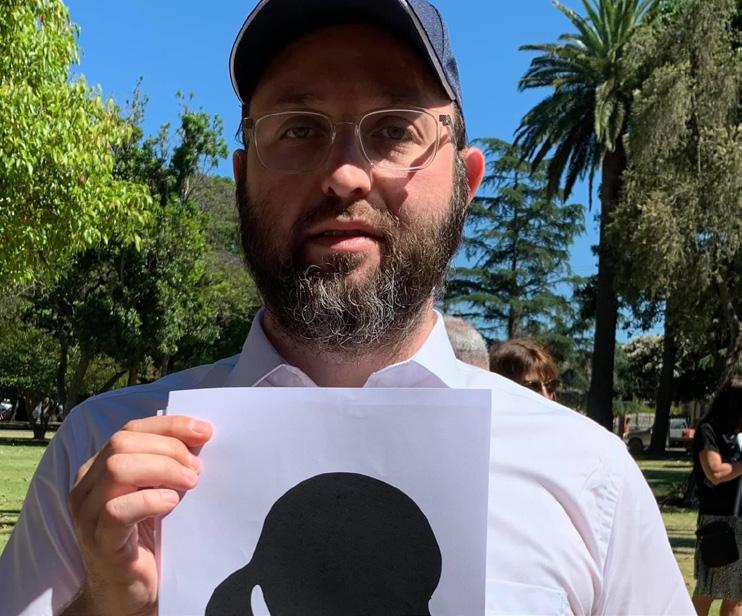
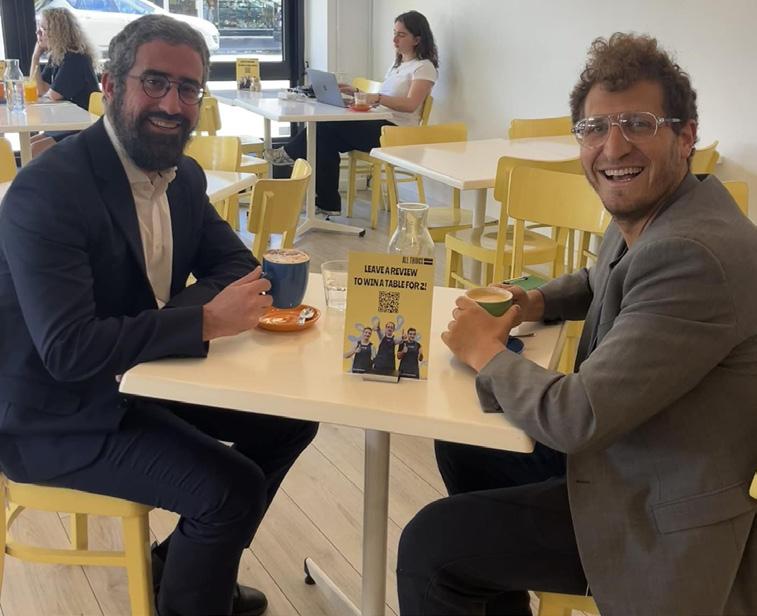


MAN UP p8 “NO” TO DOMESTIC VIOLENCE p8 HISTORIC MACCABI FIRST p9 Fostering a closer Jewish community FREE VOL. 73 Tuesday, 15 Nov, 2022 / 21 Cheshvan 5783 The King David School Athletics Gala p5 SPECIAL TORAH p5
AROUND THE COMMUNITY
ANNE-MARIE ELIAS
Divergent: (n) a drawing apart, difference, a deviation from a standard
The human brain is an extraordinary organ. Recently, neuroscientists have developed a term – neurodiversity or neuro-divergence or neuro-variance – in order to assist us to understand people who think differently.
It refers to variations in the human brain and cognition, for instance in sociability, learning, attention, mood and other mental functions.
Some examples of neuro-divergence include autism spectrum disorders, attention deficit disorders, dyslexia, dyscalculia and Tourette's Syndrome.

People with these disorders or syndromes face challenges in their dayto-day lives.
If someone you know may be neurodivergent it is important to obtain an accurate diagnosis. Many such disorders require both psychological intervention and medication.
We can help the neuro-diverse by providing a supportive environment that can make navigating our already
The divergent brain
example of this could be at a busy airport before departure, where delays are common. Preparing them for those delays – allowing extra time – will reduce anxiousness.
Those with dyslexia and ADHD are skilled problem solvers, as they are often out-of-the box thinkers with the ability to see the bigger picture. People with ASD often have superb attention to detail, which is also beneficial in the right environment.
Many with a neuro-divergent condition have the ability to hyper-focus, a strength that allows them to concentrate on something that interests them. This can aid productivity and allows individuals to engage in activities that offer enjoyment and psychological reward. Planning their time can also really help with focus.
complex world easier. Many neurodivergent people have a keen sense of curiosity. They can be most imaginative and creative. If this way of thinking can be harnessed and encouraged, they can succeed in a creative pursuit or profession.
Consider successful American singersongwriter Billie Eilish who has Tourette’s Syndrome and travels the world with her music.
It is believed that innovators Bill Gates, Steve Jobs and Richard Branson are or were neuro-diverse, along with Charles Darwin and Michelangelo.
Consider what it is like to know that you think and see the world differently to others. What would it be like to be in a classroom and not make sense of the letters on a page or to try to sit through a lecture without moving when that is not your natural predisposition?
Those with neuro-variance who face obstacles and setbacks can, usually with the help of a psychologist, develop coping strategies enabling them to become more resilient.
People with autism spectrum disorders or ADHD require a strict routine. They need to know what to expect. An
While it is thought that some neurodivergent individuals don’t have empathy or good social skills that isn’t the case. Rather, they may express empathy differently to a neuro-typical person and, as such, they may require social skills training.
Like other forms of diversity, it is important for all of us to learn more about people in our community with neuro-diversity.
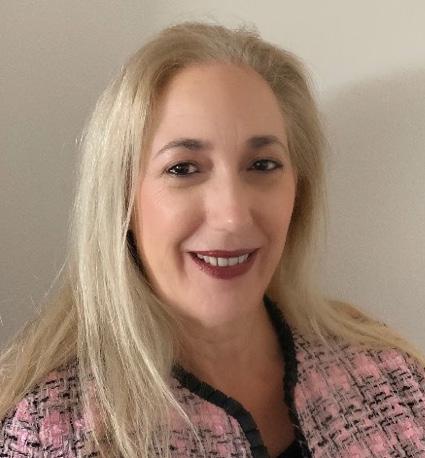
Anne-Marie Elias is a psychologist in clinical practice for 25 years.
said to her, “Behold, I have not told my father or my mother, should I tell you?”
RABBI DAVID FREEDMAN
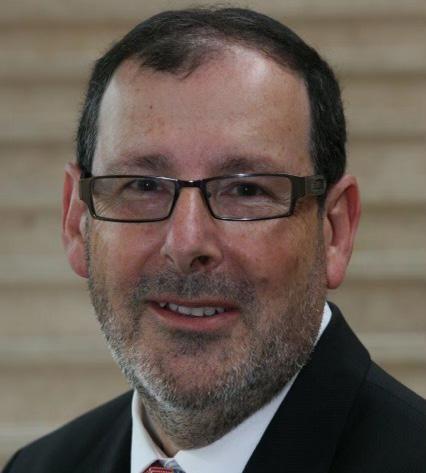
Rabbi David Freedman has once again compiled a comprehensive and creative Judaica quiz for our Melbourne Jewish Report readers. Topics are many and varied – we’re talking geographical; biblical; cultural and more and yes, all-things-Jewish in between too!
Enjoy with family and friends around the Shabbat table.
1. In the Christian Bible, the Book of Ruth follows that of Judges – in the Tanakh (The Hebrew Scriptures) which Biblical book precedes Ruth?
2. On a Hebrew keyboard is the letter known as a FINAL MEM found among the bottom row of letters, the middle row of letters or the top row of letters?
3. According to Judaism Fast Facts, CNN Editorial Research updated August 2020, which country, after Israel and the USA, has the largest Jewish population?
4. Who was Ernst vom Rath?
5. Which married couple had the following conversation: “You only hate me, you do not love me; you have put a riddle to my countrymen, and you have not told me what it is.” And he
6. Why, in Mishna Yoma, does Rabbi Yehuda rule that the Kohen Gadol (High Priest) should have a reserve wife prepared for him in the lead up to Yom Kippur?
Goats. What is the more common Israeli name for this location?
10. Achat, Shtyim, Shalosh, Arba. In Hebrew, are these ordinal numbers or cardinal numbers?
11. When and where was the Weitzmann Institute founded?
17. How many of King David’s sons are mentioned by name in the Bible i) 7, ii) 14, iii) 19?
18. Whose names are inscribed within the text of a ketubah and who signs at the bottom of the document?
19. Which French Jew founded a car manufacturing business, giving his name to the company?
20. In September 1940, 2542 ‘enemy aliens’ from Britain disembarked in Melbourne and Sydney. Most were Jewish refugees who had fled Nazi persecution in Germany and Austria. They were interned in camps near Hay and Orange in NSW and Tatura in Victoria. What was the name of the ship that brought them to Australia?
7. Tom Okker of Holland won the 1973 French Open men's doubles title with John Newcombe. What was his nickname?
8. Name two of the six letters in the most recent 2008 Hebrew version of Scrabble that have a value of 8 points, the maximum value for any letter in this version of Scrabble. (NB No final letters were included in the game.)
9. The Book of Samuel describes how Saul took three thousand men to find David.
The text says that he went to look for David near the Crags of the Wild
12. Is Daniel Barenboim a famous violinist, cellist or pianist? Where was he born?
13. What was the Cairo Genizah?
14. What custom on Yom Kippur is associated with the following verse from Isaiah 1:18 “Though your sins are like crimson, they shall be as white as snow.”
15. Teddy Kollek, Ehud Olmert and currently Moshe Lion have all held what position in Israel?
16. Which famous prayer recited on Rosh Hashanah and Yom Kippur was said to have been composed by Amnon of Mainz?
21. In the Haggadah we sing the song Dayyenu. What does the word Dayyenu mean?
22. Why were the Samaritans so called?
23. Why is the surname Kaplan often an indicator of Kohanim (i.e. Jewish priests descended from Aaron)?
24. The Carmel Winery, Somek Estate Winery and the Amphorae Winery are all close to which Israeli coastal town?
25. Name the international parent company that owns the Israeli company, Osem.
2 the melbourne jewish report | November 2022
ANSWERS PAGE 12 Good luck. Enjoy. Hopefully, learn something new about your Jewish heritage and tradition Test your knowledge
QUIZ
JUDAICA





JEWS AROUND THE WORLD
BY DR. YVETTE ALT MILLER COURTESY: AISH.COM
When the ancient Israelites were slaves in Egypt, they assimilated into Egyptian society – with three key exceptions. They never lost their distinctive Jewish mode of dress, they maintained their Jewish names and they kept their Jewish language. These three features enabled them to just barely hold on to their Jewish identity.
Scattered far and wide, Jewish communities have carved out distinctive languages, keeping them somewhat apart from the larger non-Jewish communities surrounding them. Dr Mary Connertey, Teaching Professor Emeritus at Penn State Behrend, explained that “anywhere we (Jews) have lived we created our own language”. Sometimes these “Jewish” languages are very similar to the dominant language around them, yet Jewish forms of languages contain clearly distinct elements.
Hebrew words, quotes from Jewish prayers and elements from other languages picked up in the Jewish diaspora mark “Jewish” minority languages. The history of exile is etched into Jewish languages. Here are six Jewish languages, spoken amongst Jews, as a way of preserving their communities through the years.
Yiddish
Yiddish evolved among Jewish communities in Slavic and Germanicspeaking lands in the Middle Ages. Incorporating German, Hebrew, Aramaic, Slavic and other language elements, Yiddish is written using Hebrew letters. It was widely spoken in central and eastern
Six little-known Jewish languages
European communities from the early Middle Ages until the decimation of Jewish communities in the Holocaust and continues to be spoken in some Jewish communities in Europe, Israel and in North and South America today.
In time, a number of different Yiddish dialects arose in Jewish communities throughout eastern Europe.
“In each new setting, elements from local vernaculars have been absorbed, modified to suit the Yiddish idiom,” noted historians Mark Zborowski and Elizabeth Herzog. “Whoever knows Yiddish can understand the Yiddish of anyone else, even though some of the words may be incomprehensible.
Yet each region has its own accent and idioms, which can be recognised and identified.” (Quoted in Life is With People: The Culture of the Shtetl by Mark Borowsky and Elizabeth Herzog, Schocken Press: 1952.)
Ladino
Ladino – sometimes variously called Judeo-Spanish, Judezmo, Judio, Jidio or Spanyolit – is a language written with Hebrew characters that has been spoken by Sephardi Jews around the world for generations. It has its origins in Medieval Spain where the country’s large, vibrant Jewish community developed a unique way of speaking, blending Hebrew and even some Arabic words with Medieval Spanish. Facing persecution from Islamic rulers in Spain, some Spanish Jews moved to North Africa in the 1300s and 1400s, bringing Ladino with them, establishing Ladino-speaking communities in Morocco.
When Spain was unified under Catholic rule in 1492, the monarchs King Ferdinand and Queen Isabella marked the milestone
by forbidding any Jews to live in the country on pain of death. 200,000 Jews fled the country, bringing Ladino with them.
Ladino-speaking Jewish communities existed for hundreds of years in North Africa, Yugoslavia, Romania, Greece, Bulgaria, Turkey, Egypt and the Land of Israel. Through the years, local variants incorporated new linguistic elements from Turkish, French, Arabic and Italian. Today, Ladino is still spoken by thousands of Jews, many of them elderly.
Yevanic Jews living in the northern regions of Greece developed their own language called Yevanic, also known as JudeoGreek. The area was home to Romaniote Jews. Professor Mary Connerty explains “they weren’t Sephardi nor Ashkenazi” but a separate group of Jews who traced their origin to Jews from the ancient Byzantine empire. Romaniote Jews developed their own dialect of the local Greek language. Professor Connerty believes that became more distinct and changed into Yevanic during the Middle Ages and Renaissance. “Beginning with the Ottoman invasion (the Ottoman empire captured Athens in 1458), the language started changing,” Professor Connerty explains. The local Jewish dialect evolved into something that was unintelligible to non-Jewish Greek speakers. The name Yevanic derives from the Hebrew word for Greece: Yavan.
Yevanic contained many Greek words and also incorporated Hebrew, Arabic and Italian. It was traditionally written using Hebrew letters, though some Jews began to switch to writing the language using Greek letters in the 1800s. Romaniote Jews prayed from Jewish prayer books written in Yevanic. There were also some small
communities of Yevanic speakers in Turkey. The Constantinople Pentateuch (Jewish Bible) is one of the oldest surviving books written in Yevanic, dating from 1547.
“There is still a tiny population of Yevanic speakers in Turkey,” Professor Connerty explains “and a few still in Iran”. She estimates that only a few hundred people speak Yevanic today. In northern Greece, there were about 10,000 Yevanic speakers on the eve of World War II. After the Holocaust, just 149 Yevanic speakers had survived. Today, the language is kept alive by a few families in Jerusalem and New York – and by scholars who continue to research Yevanic and other small Jewish languages.
Bukharian
For generations, Bukharian Jews lived in scattered communities across Central Asia, primarily in present day Uzbekistan and Tajikistan. They trace their history back to Biblical times, when King Nebuchadnezzar of Babylonia conquered ancient Israel, destroying the first Jewish Temple in Jerusalem in 587 BCE and exiled many Jews north into Babylonia. Although many Jews soon returned to Jerusalem and other Jewish lands, some Jews remained in exile, migrating even further north, into Central Asia.
These Jews were sometimes known as Bukharian Jews because many lived under the reign of the Emir of Bukhara. Jews often called themselves Isro-il (Israelites) or Yahudi (Jews). They developed a distinct dialect of the local Tajik language, which incorporated many Hebrew words, as well as language elements from elsewhere in Central Asia and became known as JudeoTajik. It is also known as Bukhori or Bukharian.
Walk Against Family Violence Charting your own path
Against Women. It is also the start of 16 days of activism against gender-based violence.
Led by Jewish Care, 14 Jewish community organisations will band together at Caulfield Park at midday on Friday, 25th November as part of a statewide anti-violence event.
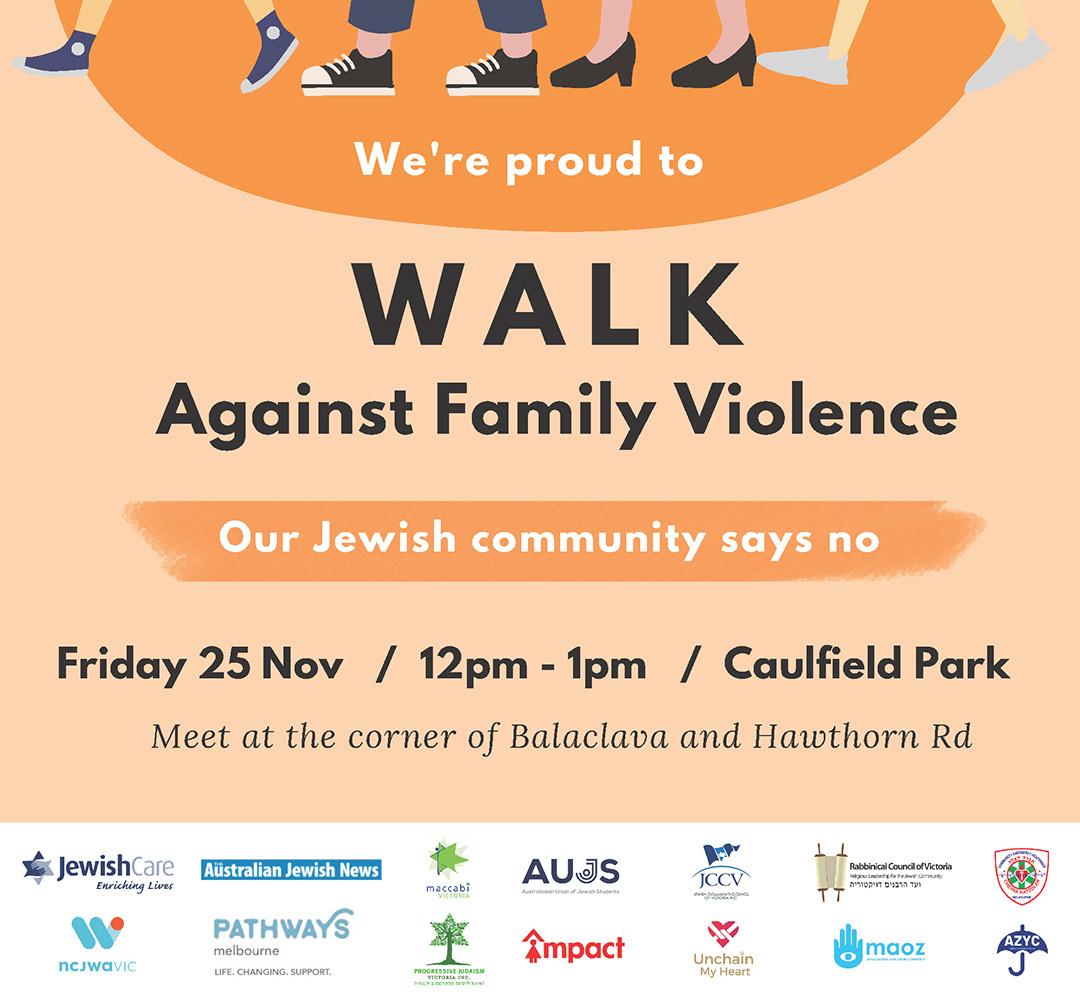
Now in its 14th year, the Walk Against Family Violence marks the International Day for the Elimination of Violence
The walk seeks to raise awareness of the impact of family violence across Australia and bring attention to the lives that have been lost.
Those wanting to take part should look for orange balloons and the Jewish community banner at the corner of Balaclava and Hawthorn Roads.
Late last month Pathways Melbourne in collaboration with several nonprofits globally marked the second International Day of Choice.
The International Day of Choice (Yom Ha’Bechira) was established in 2021. Its purpose is to raise awareness about the challenges faced by Jews who have chosen to follow life paths outside the communities in which they were born and raised.
On 27th October this year, Pathways Melbourne hosted a picnic, which included a discussion about the ways Jews may choose to express their personal values and identities.
Dov*, who has been involved with Pathways since 2020, describes Yom Ha’Bechira as “a special celebration of the strength and commitment to selfdetermination that people on these journeys share”.
Together with the Justin Art House Museum, Pathways Melbourne also presented a lively panel discussion exploring the complex topic of Judaism and gender. It did so against the backdrop of the museum’s current gender and art exhibition.
Pathways Melbourne was established in 2014 to address the emerging needs of a specific segment within the city’s vibrant and diverse Jewish community.
Its mission is to support and empower people from ultra-Orthodox backgrounds who find themselves questioning their lifestyle, practices or beliefs, and those who feel that they just don’t fit in well. Over the last eight
years, Pathways Melbourne has worked with other Jewish community service organisations, including JewishCare, and with the support of 30 plus volunteers to provide confidential support to this cohort.
The assistance it provides also extends to those who might be experiencing isolation, mental distress and food or housing insecurity. Its support has extended to those who are neurodivergent and others who identify themselves as LGBTQI+.
Importantly, the organisation does not aim to sway anyone away from Orthodoxy or religious affiliation, rather to respect and support Jews in their efforts to choose their own direction.
Art therapist and counsellor Dassi Herszberg, who also sits on Pathways’ advisory panel says “I am seen as an individual and my unique differences are accepted and celebrated”.
Pathways Melbourne has received support from family foundations and the local Jewish community. It has also had funding from Bendigo Bank and the Glen Eira and Port Phillip Councils.
As a result, the organisation has been able to develop bespoke services and resources. They include individual mentoring from Jewish volunteers with “lived experience”, imparting education and employment advice, and referrals to professional third-party services (e.g. medical, allied health and legal professionals).
Pathways Melbourne’s events are Shomer Shabbat and Kosher catered. If you or someone you know requires confidential support, please visit www. pathwaysmelbourne.org.au or email info@pathwaysmelbourne.org
4 the melbourne jewish report | November 2022
JEWISH CARE PATHWAYS MELBOURNE
CONTINUED
ON PAGE 6
Recently Leibler Yavneh College hosted a very special Hachnasat Sefer Torah celebration, to welcome to the College the Vorchheimer Family Torah. The decades-old Torah travelled around the world before finding its place at Yavneh.
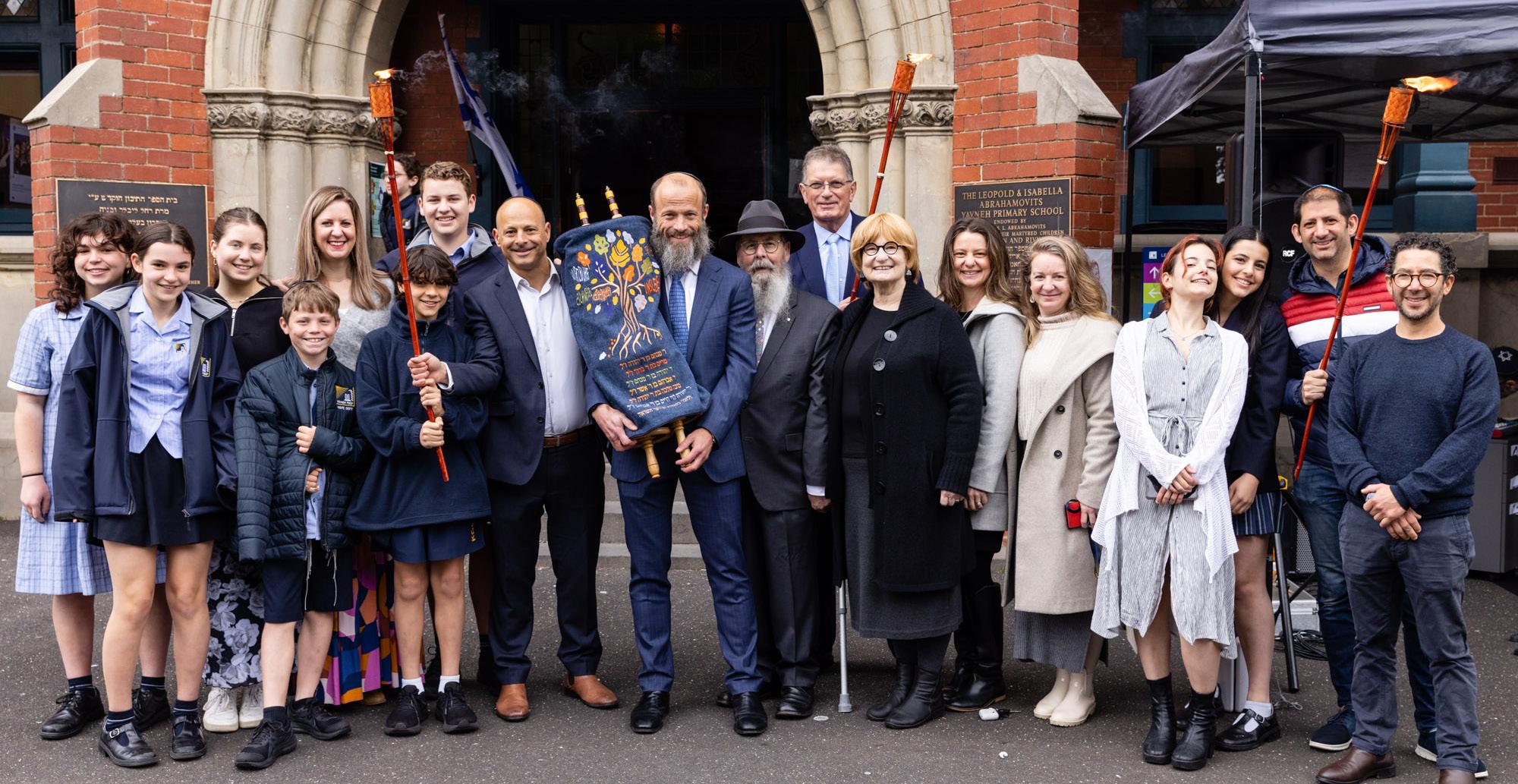
At the celebration, Menachem Vorchheimer explained its significance. “It has made its journey from the hands of its rescuers in Eshwege, Germany, taken refuge in the United States and now arrives at its new home at Yavneh.”
The Torah belonged to Menachem’s father, Ludwig Vorchheimer, obm. He was one of the lucky ones, escaping Germany on the Kindertransport – a train sponsored by English Jewry – which transported Jewish children, without their parents, to safety in England. After a period there, which included
and then moved again to the USA. It is believed the Torah was one of several saved from Eschwege, Germany by Cantor Erich Neumann, with the help of his bar mitzvah boys, before Kristallnacht. Originally donated by Ludwig to the Ohav Shalom Shule in New York, it was returned to the Vorchheimer family in 2005 when the synagogue closed. The restored Torah was recently used at Menachem’s nephew’s bar mitzvah in New York and, next year, will be in use again for Ludwig’s grandson’s bar mitzvah celebration at Yavneh.
“This is an incredibly special occasion for our family, as we feel connected to all the generations that have come before us and we feel that my father is especially close. In its new home, Yavneh, our Torah will be surrounded by its family – by Aba, Ber, Shira and Tehila, the grandchildren of my father, who
will be here in the same building as his Torah. We know that the Torah will enjoy this part of its journey, as it experiences the ruach, connection to Israel and love of Torah and mitzvot that this school lives and breathes,” Menachem said.
“We are thrilled to house this extraordinary Torah,” said Yavneh principal Shula Lazar. “Our college is well known for warm community, committed to a relationship with Hashem based on the study of Torah and adherence to its
values and mitzvot. I know that the history that accompanies this special Torah will be embraced and celebrated by our staff and students. It gives me such joy to receive this special and meaningful gift and I thank the Vorchheimer family.”



Leibler Yavneh College is an authentic, practicing, Modern Orthodox religious Zionist school, well known and loved for its strong spirit and inclusive environment. For more information on the College, visit: https://yavneh.vic.edu.au
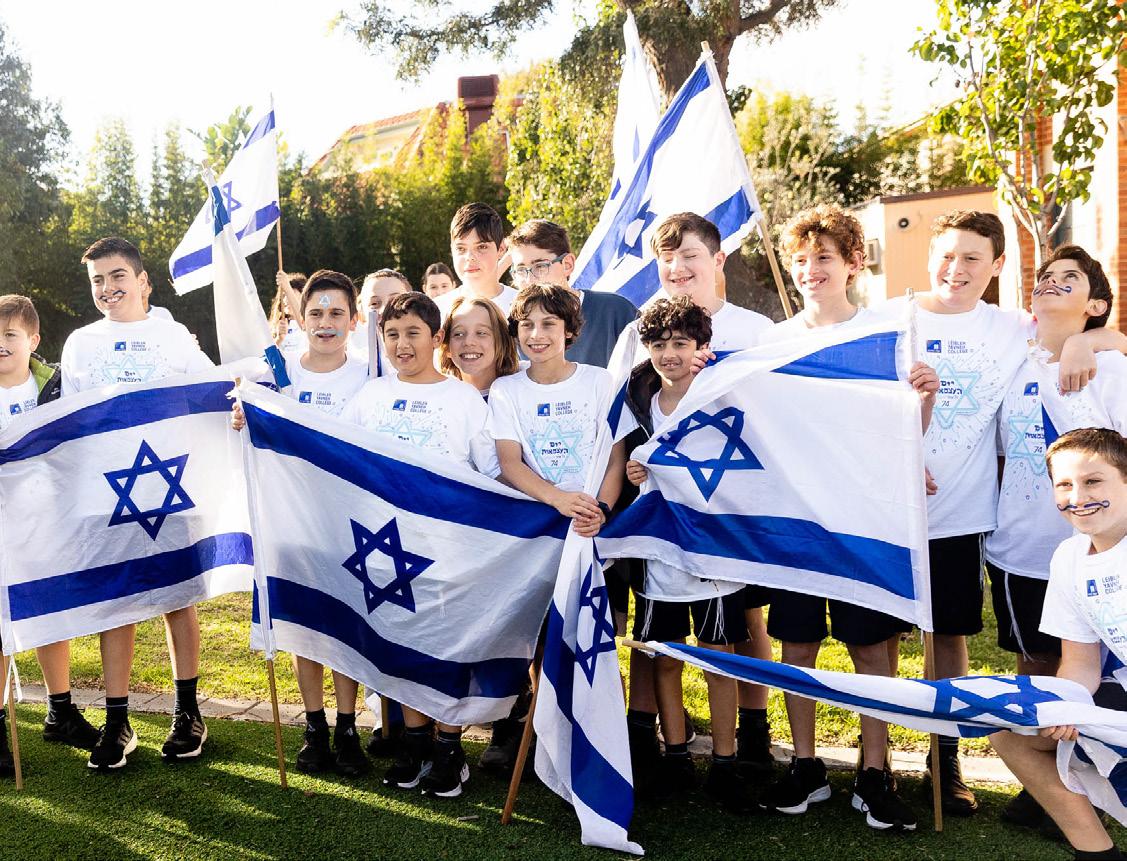
the melbourne jewish report | November 2022
The King David School annual Prep to Year 5 Inter-House Athletics Gala was celebrated in fine style recently. Mazal Tov to the winning House – Galil.
Winners are grinners Exceptional Torah THE KING DAVID SCHOOL LEIBLER YAVNEH COLLEGE GEMARA STEAM ING HALACHA IVRIT TALMUD INTERSCHOOL SPORT PLAYS CHEVRUTA LEARNING WELLBEING STEAM PLAYS ROBOTICS JEWISH LIFE WELLBEING TANACH TANACH WELLBEING MUSICALS IVRIT JEWISH ELECTIVES TALMUD MUSICALS YOU ONLY NEED ONE... IVRIT STEAM TANACH To book a tour of the College, email enrolments@yavneh.vic.edu.au or call 9528 4911 today. JEWISH ELECTIV King David Scholarships 2024 Apply online: www.kds.vic.edu.au Applications close: Friday 17 February 2023 Enquiries: 03 9527 0102 The extended Vorchheimer family
Six little-known Jewish languages
FROM PAGE 4
Bukharian became the first language for many Jewish communities in the area. Even when they were living in areas where their non-Jewish neighbours spoke Uzbek, not Tajik (which was much more similar to Bukharian), Bukharian Jews would communicate among themselves using Judeo-Tajik or Bukharian.
In the late 1800s, many Bukharian Jews began immigrating to Israel. The Bukharian Quarter in Jerusalem became a thriving centre of Bukharian culture. Rabbi Shimon Hakham, a Central Asian-born Bukharian Jew living in Jerusalem, translated many works into Bukharian and sent them back to his co-religionists in Asia. The Bukharian language, which had been primarily oral for centuries, began to develop a literary character in the Jewish state.
Between 1910 and 1916, a Bukharianlanguage newspaper called Rahamim was published, first in the town of Skobelev and then in Kokand, both in Uzbekistan. Another Bukharian language newspaper called Roshani (“Light”) ran from 1920 to 1930; in 1930 it changed its name to Bajroqi Minat (“Life of the Workers”) and continued running until 1938. During this period, Jewish schools in Uzbekistan and Tajikistan taught students in Bukharian, using Bukharianlanguage schoolbooks.
This period also saw a transition from using Hebrew letters to write Bukharian texts to using Latin or Cyrillic letters instead. Today, there are over 200,000 Bukharian Jews: many live in Israel and the United States. While Bukharian is no longer widely spoken, many older Bukharian Jews continue to
remember and speak this distinctive Jewish language.
Judeo-Arabic
Distinct forms of Arabic spoken by Jewish communities in the Middle East began to evolve as early as the 8th century, according to New York University Professor Benjamin Hary. He described various versions of JudeoArabic as a “language variety” rather than a fully distinct language. “I consider JudeoArabic in general a language variety that has its own history and variety all the way from the 8th century until today – and in the past two to three hundred years local varieties have developed in Yemen, the Maghreb, Iraq and Egypt that are unique to this local variety.”
One of the most distinctive aspects of all these diverse Judeo-Arabic dialects is the use of Hebrew letters – rather than Arabic – to write many Judeo-Arabic texts. Another difference from non-Jewish forms of Arabic is pronunciation. Professor Hary gives the example of Egyptian JudeoArabic: Jewish speakers use a long “oo” vowel sound whereas standard Egyptian pronunciation would say “i”. In Yemen, Judeo-Arabic dialects sounded even more distinct from the language spoken by nonJews, at times employing radically different pronunciation from that of local non-Jewish Arabic speakers. Judeo-Arabic dialects also incorporate Hebrew and Aramaic words, as well, sometimes, as older Arabic words that have fallen out of use in the wider non-Jewish population.
Professor Hary notes that some of the most notable works of Jewish literature were written in Judeo-Arabic. Judah Halevi (1075-1141), for instance, “composed his 12th-century classic work, The Kuzari (Kitab al-Xazari), in a part of the Iberian Peninsula
that had recently been re-conquered by Christians, but he nonetheless wrote it in Judeo-Arabic, the language of the educated Jewish classes.” Maimonides’ wrote his classic Jewish work Guide for the Perplexed in Judeo-Arabic while he was living in in the late 1100s, Professor Hary notes; the name in Judeo-Arabic was Dalalat al-Ha’irin.
Judeo-Italian
In the Middle Ages, Italian Jews developed a unique mode of speaking, known by scholars today as Judeo-Italian. Written in Hebrew letters, Judeo-Italian flourished after Jews were confined to small ghettos: all-Jewish neighbourhoods in Italian towns where Jews were forced to live. Professor Sandra Debenedetti Stow, who retired after a career teaching at Israel’s Bar Ilan University, recently shared her research into this distinctive language.
Since Italian Jews were so confined in the Middle Ages, the language traditions they developed were intensely local. “What the Jews spoke and wrote was mainly the dialect spoken in their places of residence, so we speak of Judeo-Roman, JudeoPiedmontese, Judeo-Venetian and so forth,” Professor Stow explains. Italian Jews incorporated “Italian archaic terms and ... the presence of Italianised Hebrew terms”.
Judeo-Italian used “verbs like ‘achlare’ (to eat), from the Hebrew leechol and the verbal ending -are, ‘lechtire’ (to go) from the Hebrew lalechet and the ending ire, ‘dabberare’ (to speak), from the Hebrew ledaber, adjectives like ‘ammazzallato’ (lucky) from the Hebrew mazal,” Professor Stow explains. Some Hebrew terms became adapted to Italian linguistic components too. Professor Stow notes that talledde was a Judeo-Italian form of the Hebrew word
tallit (prayer shawl). Some Judeo-Italian words were interesting syntheses of Italian and Hebrew terms. Sone meant anti-Semite in Judeo Italian: it came from the Hebrew word sone (hater). Marorre meant an ugly thing in Judeo Italian; it was derived from the Hebrew word for bitter, maror.
Beginning in the Renaissance, Judaic languages in Italian became more Italianised; soon they were simply dialects of local forms of Italian. “Today there are no genuine speakers of Judeo-Italian dialects left inside Italy,” Professor Stow notes “and to the best of my knowledge there aren’t any speakers outside Italy”. However, in Rome today there is movement among some younger Jews to revive Judeo-Italian and its traditions.
Today, most of these Jewish languages – and other even smaller and lesserknown Jewish languages – are considered endangered, their native speakers aging and dwindling. In part, this abandonment of traditional Jewish languages reflects the robust state of Israel as the homeland of the world’s Jewish communities.
As Jews have moved to Israel from across the globe, their children grow up conversing in Hebrew. In some cases, Jews have abandoned their traditional languages as anti-Semitism decreased and Jews were allowed to socialise and educate their children in their countries’ dominant languages.
These Jewish languages reflect the history of our ancestors around the world. The poetry, songs, sayings and writings in Jewish languages are a crucial record of how our ancestors lived; they are a tribute to the rich Jewish lives that our forbearers led.
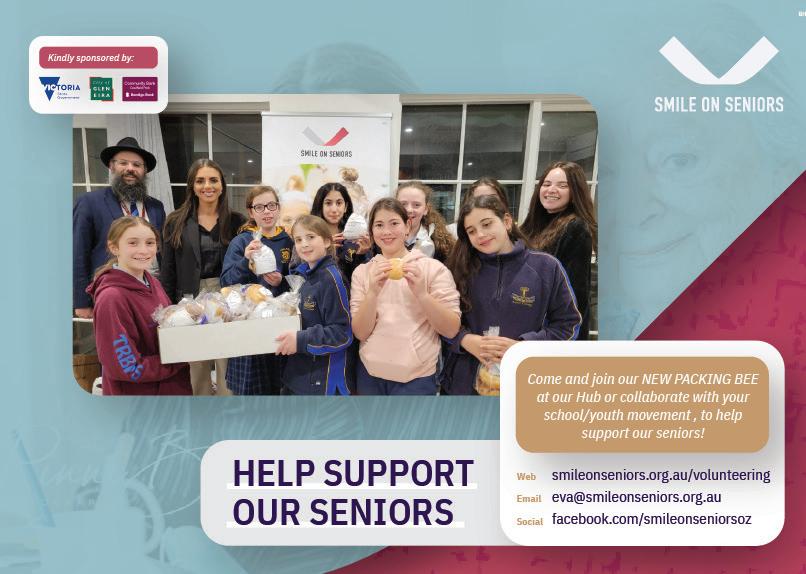
6 the melbourne jewish report | November 2022
MELBOURNE
In November 2020, UIA Australia held a Giving Day using Charidy’s online platform. In 24 hours, 250 volunteers raised $2.4 million, which, at the time, broke Charidy's record the highest amount of money raised and highest number of donors (more than 2,500) for a Jewish organisation in Australia.
Funds raised supported the construction of a new Amigour Home in Ashkelon, southern Israel, providing a home for Holocaust survivors and the vulnerable elderly.
UIA Australia is extremely proud to see this vision become a reality. The Ashkelon location is one of the 57 sheltered housing facilities operated by Amigour, Israel’s leading operator of public and sheltered housing for the elderly. Today, in excess of 7,500 disadvantaged seniors across the country enjoy affordable housing and independent living.
The situation is particularly severe for Holocaust survivors and immigrants from the former Soviet Union, who lack financial resources and an adequate network of family and friends. Following the horrors these people endured, they arrived in Israel and were finally – possibly for the first time in their lives – able to live without fear.
There are approximately 180,000 Holocaust survivors living in Israel. One in three live below the poverty line.
Two years on: Amigour Ashkelon opens
has two emergency staircases and each apartment has a “safe room”. There is also a social club, funded by Australian donors, at the centre of the complex. Residents participate in Hebrew and English language classes, exercise sessions, lectures on health and nutrition, handicrafts’ workshops, choral groups, computer classes and more. These provide intellectual and cultural stimulation along with social interaction.
Trips around Israel, visits to museums and the theatre, and holiday celebrations offer the opportunity for personal enrichment. Dedicated on-site staff include social workers, diversional therapists and caregivers helping residents, ensuring all their needs are met.
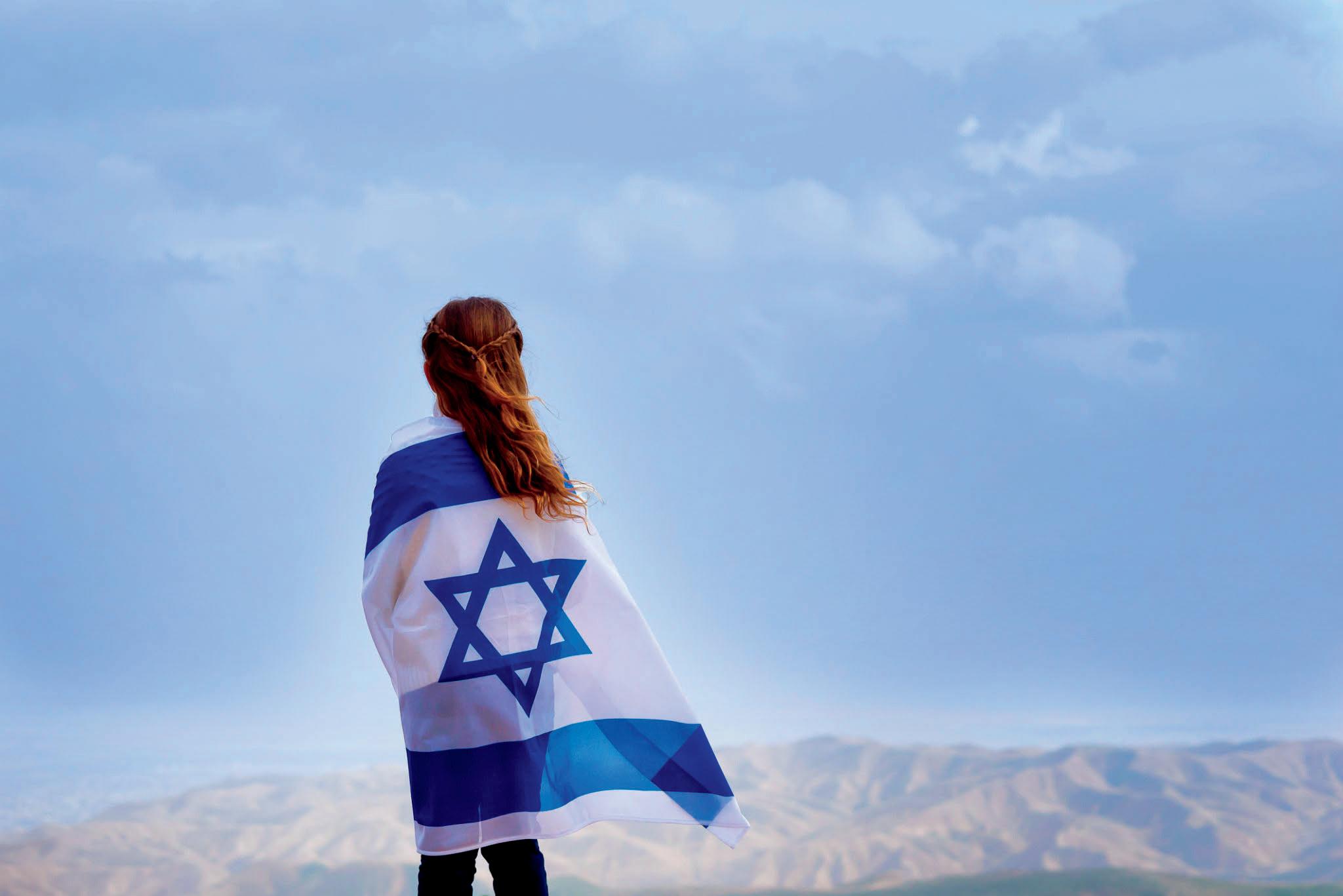
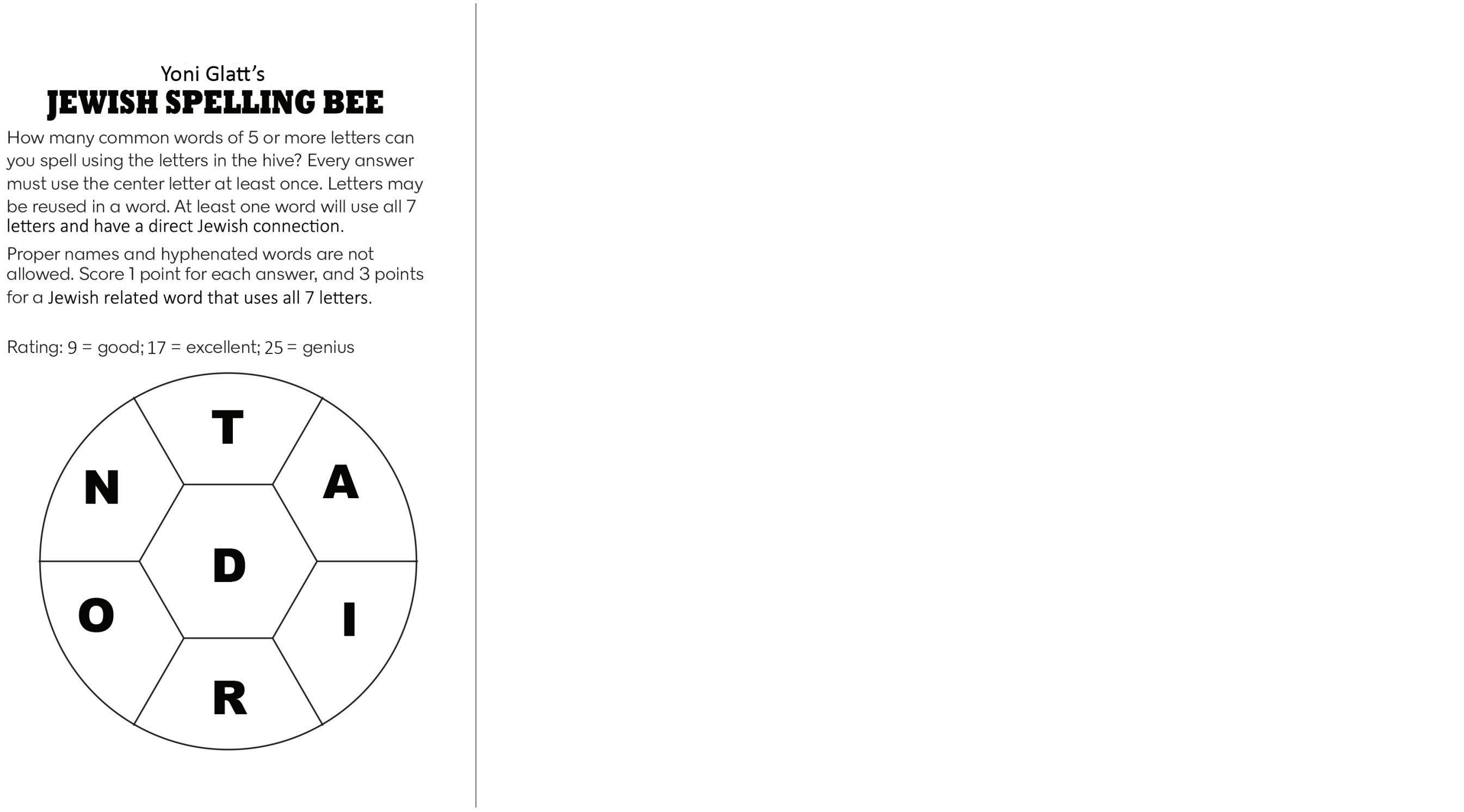
The Israeli government matched funds raised by UIA from Australian donors.
This served to emphasise the strong partnership Keren Hayesod-UIA has with the government and The Jewish Agency for Israel, working together to support Israel’s national priorities. A donor recognition wall has been erected to acknowledge the generosity of donors.

UIA Australia CEO Yair Miller OAM says an undertaking of this scale reinforces the vital part UIA Australia plays in the global UIA family. “We thank all the matchers, donors, leadership, professional staff
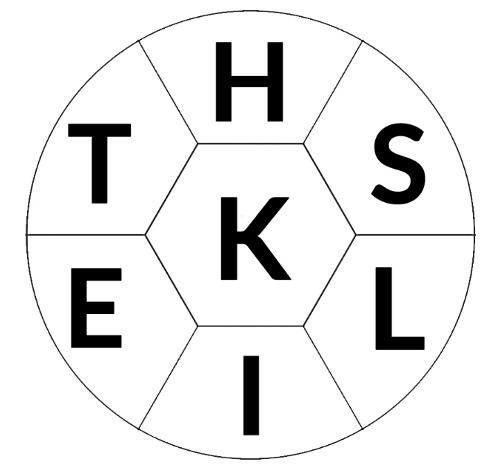
Overlooking the Mediterranean coast, 50 kilometres south of Tel Aviv and just 13 kilometres north of the Gaza Strip, Ashkelon is the largest Amigour public
Yoni Glatt has published more than 1,000 crossword puzzles worldwide, from the LA Times and Boston Globe to The Jerusalem Post. He has also published two Jewish puzzle books: "Kosher Crosswords" and the sequel "More Kosher Crosswords and Word Games".
7 the melbourne jewish report | November 2022
UIA
AROUND THE COMMUNITY
we
the
can work, but these
are the most common): ANSWERS PAGE 12
Recognition wall for UIA Australia donors at the new social club at Amigour Ashkelon
is a list of some common words (Yes,
know there are more words in
dictionary that
words
How many common words of five or more letters can you spell using the letters in the hive? Every answer must use the centre letter at least once. Letters may be reused in a word. At least one Jewish word will use all seven letters. Proper names and hyphenated words are not allowed. Score 1 point for each answer and 3 points for a Jewish word that uses all 7 letters. Rating: 20=Good; 24= Excellent; 27= Genius
RABBINIC THOUGHT
A few years ago, my son attended a Barmitzvah program at his school called "Man Up”. The graduation dinner function was very impressive as the boys demonstrated and discussed the powerful lessons learned.
What struck me was how they completely changed the traditional, outdated and often dangerous concept of manning up. By definition that is about being “brave or tough enough to deal with a difficult or unpleasant situation". In other words, the idea that you have to man up and take it.
The “Man Up” program upended that concept. Instead, they were taught that manning up meant to take responsibility for themselves and the world around them. But it went further to incorporate displaying kindness to all creatures, being mindful of their actions and appreciating their Jewish heritage.
I was reminded of the importance of this shift in thinking, as this month marks the International Day for the Elimination of Violence against Women.
One simply needs to read reports about the ongoing scourge of domestic violence and abuse to
Man up
understand its scale. As Victoria Police chaplain, police members often tell me that most of their response calls are related to domestic violence.
Domestic violence does not discriminate. Racial/ethnic, socioeconomic, religious, geographic and occupational groups are all affected. And the Jewish community is not immune. There are many types of domestic violence, including intimidation, verbal, physical, financial, emotional and sexual abuse, and Gett refusal.
It has been my privilege to participate in Jewish Care's March Against Family Violence for a number of years and I intend to do so again this year. During the march, those taking part hold pieces of paper with the names and ages of those women who have been killed because of family violence that year. That is always a huge wake-up call. Our collective responsibility is to prevent more women from becoming statistics. Although men are also subject to domestic violence and this is also unacceptable, the harsh reality is that women are disproportionately affected.
Each of us has a role to play. The idea that it is "someone else's problem" is unacceptable. How can we continue to work towards a day when
we no longer need such a day? Many organisations have been working tirelessly on this subject. Breaking the stigma is a recurring theme. It is shocking how stigmatised this topic still is. I officiate marriages of young couples and we have classes leading up to the wedding.
We talk about Shalom Bayit – the ideal home.
We hope relationships are nurtured and respected in this harmonious home.
“No” to domestic violence
RABBI GABI KALTMANN ARK CENTRE
Our country is facing a crisis, one that seems to affect people of all ages and backgrounds, and in all locations. I am not talking about the effects of COVID-19, rather the scourge of family violence that has been an issue in our community for far too long.
Domestic violence is a pattern of abusive behaviour in which one person seeks to control and dominate the other. It does not take one single form and the ongoing nature of it often shatters a victim’s confidence and their ability to leave their violent partner. Escalations in behaviour by the perpetrator are extremely common.
While physical violence is common, sexual, emotional, social, spiritual and economic abuse can be equally devastating. Isolating a person from their family and friends, as well as controlling their access to money, preventing them from making life choices and threatening them are, unfortunately, not a rarity.
While for many industries and services there is an option post-COVID to move to online or web-based-services, victims of domestic violence are more limited in their choices. They are often in an unsafe environment, being monitored and unable to access services.
Jewish Care advises that almost 50 per cent of the calls it receives are from people – the vast majority of them women – experiencing domestic violence.
Internal Jewish Care statistics note that on average it takes a Jewish woman twice as long to report or seek help in relation to domestic violence than women in the general community.
Reading about the uptick in domestic violence feels overwhelming and disheartening. So, what can be done? What can our community do to help those in need?
To make change, we have to promote respectful relationships and invoke
attitudes that don’t propagate the unacceptable.
Eliminating domestic violence requires a range of interventions. They include increased support for victims who want to leave their partners and more access to mental health counselling, as well as government and community support to indicate such behaviour will not be tolerated.
Jewish Care has been at the forefront of tackling domestic violence. It
The possibility of a different reality seems unimaginable. However, these are ideals, not reality. It is important to create a safe space for women to report abuse and feel comfortable in coming forward. They should not be judged or spoken about for taking that brave step. We must also call a spade a spade. It is primarily a men's issue. While women suffer from it, we need to put the blame on the perpetrators and not the victims.
I know some organisations have created ambassador programs, but I feel that the concept of recognising men as ambassadors is almost like saying men who don't commit violence or who speak out against it should be recognised or rewarded. The perception is that this behaviour is admirable. No, this should be the only type of behaviour that is accepted. It should be the norm.
Last but not least, I think we should really consider why a man would hurt the woman he claims to love. In the home, at work and in our communities, girls and women deserve to be free from violence, abuse, intimidation and control. We can only accomplish this together and it will benefit not just women, but men, as they will experience better relationships and make stronger emotional connections.
released brightly coloured posters with slogans such as ‘There's no excuse for abuse” and “Relationships should feel safe”. These posters also provided information about where to seek help. Jewish Care’s annual Walk Against Family Violence will take place at Caulfield Park on 25th November.
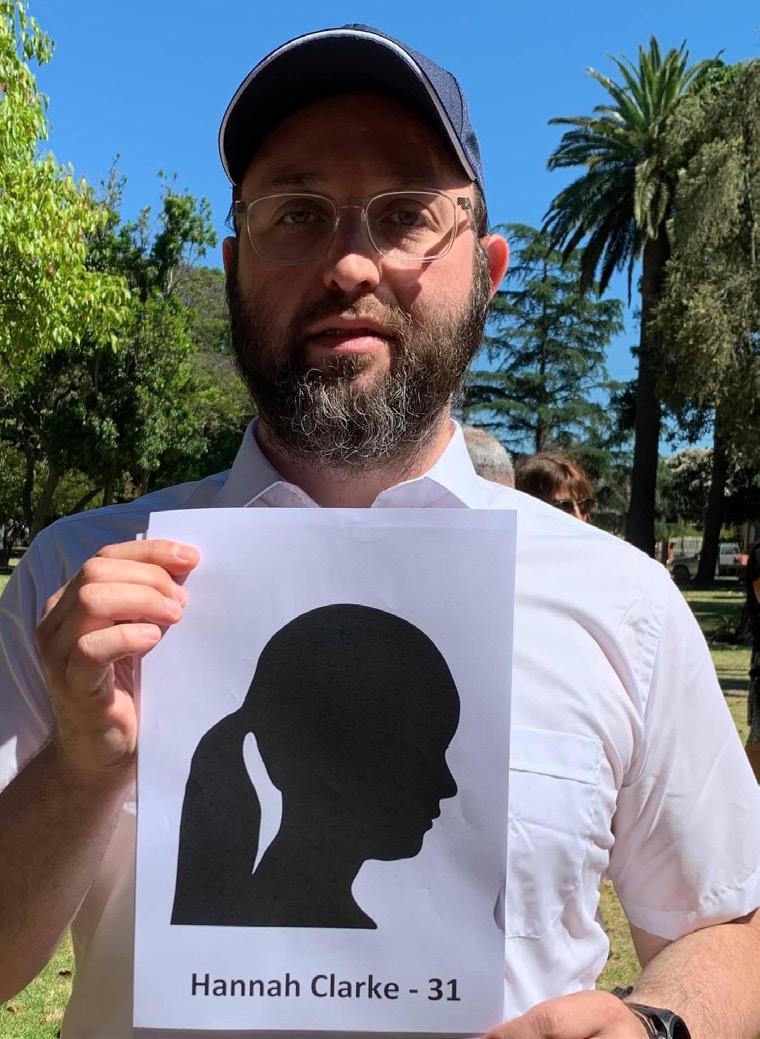
There have been some positive developments post pandemic in relation to funding for domestic violence help organisations and mental health services. Millions of dollars were set aside for this in the Federal Budget.
There has also been a greater understanding of the issues that lead to domestic violence. In Victoria and NSW there are now dedicated Ministers tasked with tackling domestic violence.
The pandemic has shown us that things can be done rapidly. For too long society has swept the issues relating to domestic violence under the carpet and pretended it didn’t exist. No longer.
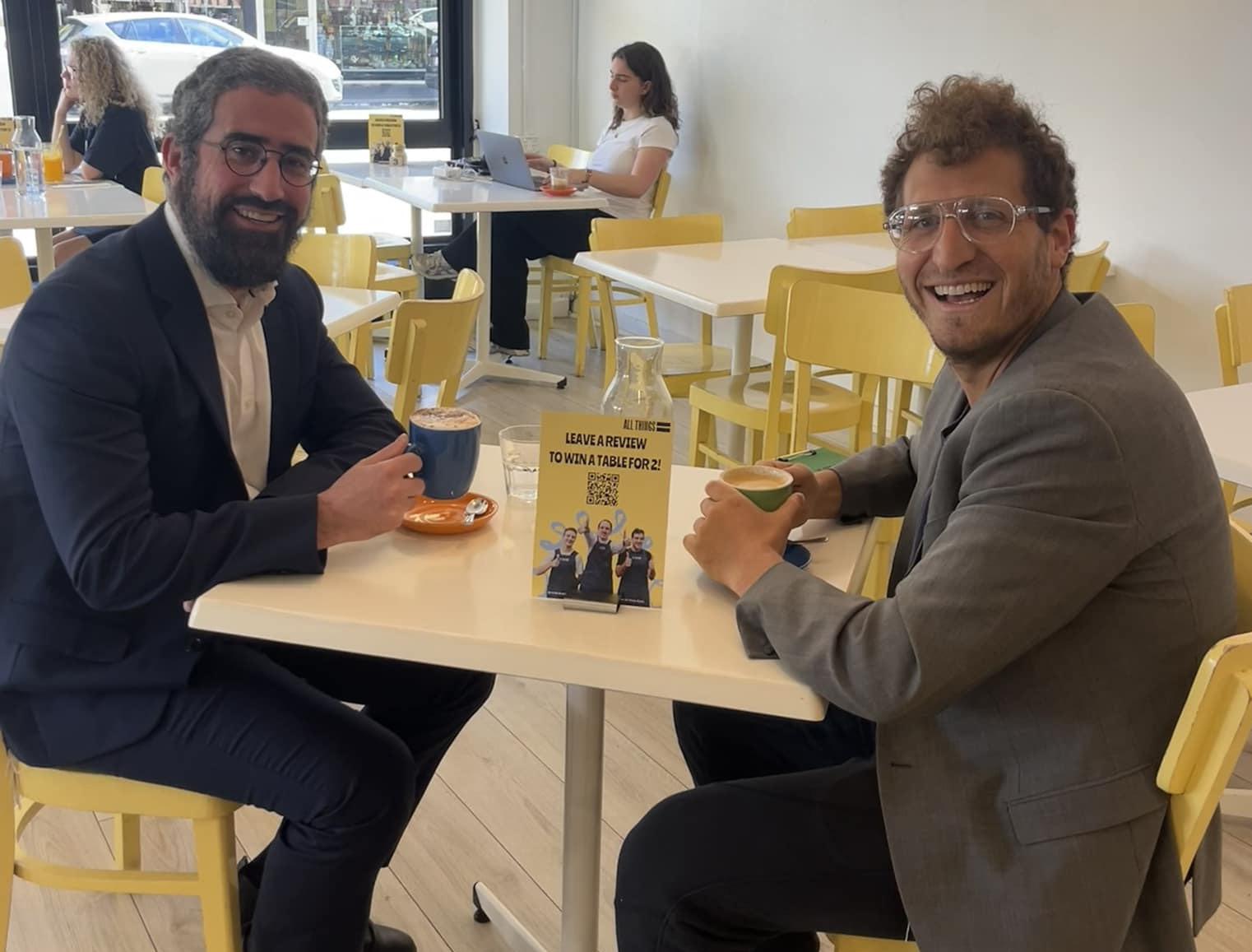
I am pleased to be able to say that is no longer taboo for rabbis to discuss domestic violence and the ways in which community leaders can combat and assist victims in need.
Anyone who may be experiencing domestic violence should reach out to a support organisation. They need to know the situation is not their fault and there is help available.
If necessary, please call 1800 RESPECT or Jewish Care Victoria on 8517-5999.
8 the melbourne jewish report | November 2022
RABBI DANIEL RABIN
Rabbi Daniel Rabin
From left: Rabbi Yaakov Glasman AM and Rabbi Gabi Kaltmann are both White Ribbon Ambassadors
Historic first for Maccabi Care during the golden years


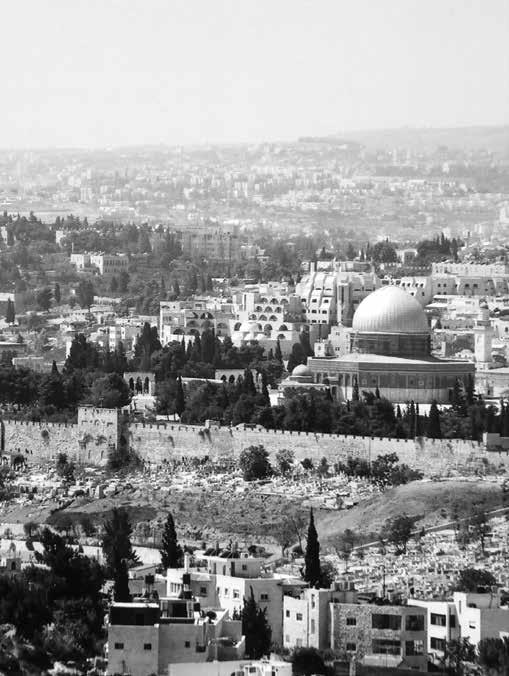
Netball became her sport of choice and over the years she has been a player, coach and administrator.
SMILE ON SENIORS
This month, for the first time in its near 100year Maccabi Victoria elected a female president.
Sharon Roseman became co-president, alongside Dean Mohr.
Brian Swersky, who joined the board as chair in 2012 and has been president since 2016, stepped down from his role.
Mr Swersky thanked the many people who have provided support, counsel and hard work during his tenure.
He said that during his time at the helm, notwithstanding COVID-19, Maccabi Victoria “has grown, become more professional, is financially secure and is recognised as a community leader.”
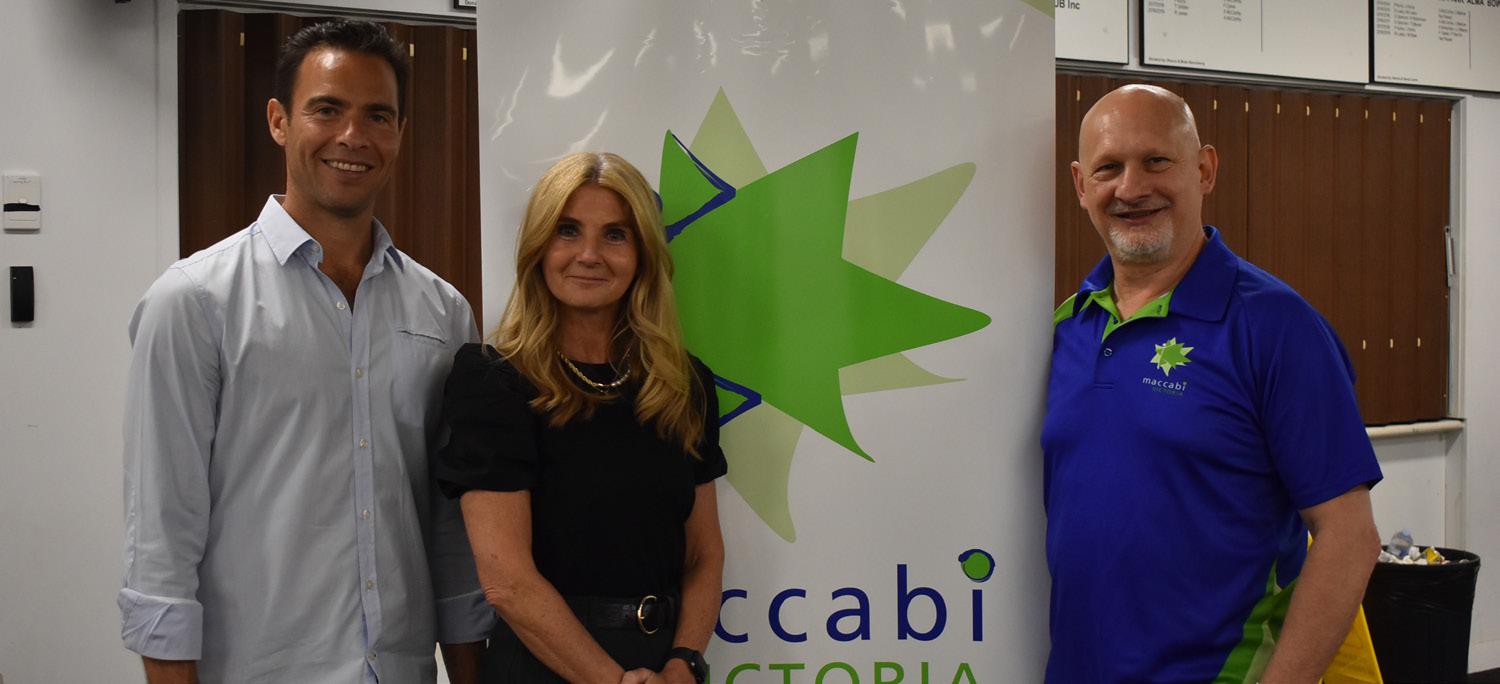
Sharon Roseman has been involved with Maccabi and AJAX since she was a child.
Sharon is vice president of the Stonnington City Netball Association and director of its representative program.
Her Maccabi highlight was as team manager of the gold medal winning Australian Open Netball Team at the 2013 Maccabiah Games.
Dean Mohr was also with Maccabi through his formative years.
That started as a participant in football, volleyball and table tennis and evolved as a supportive father and coach of his son’s basketball and football team.
Professionally, Dean is managing director of Bodycare Workplace Solutions, leaders in workplace health, safety and injury prevention in Australia and New Zealand.
He has been a member of the Maccabi board since 2016.
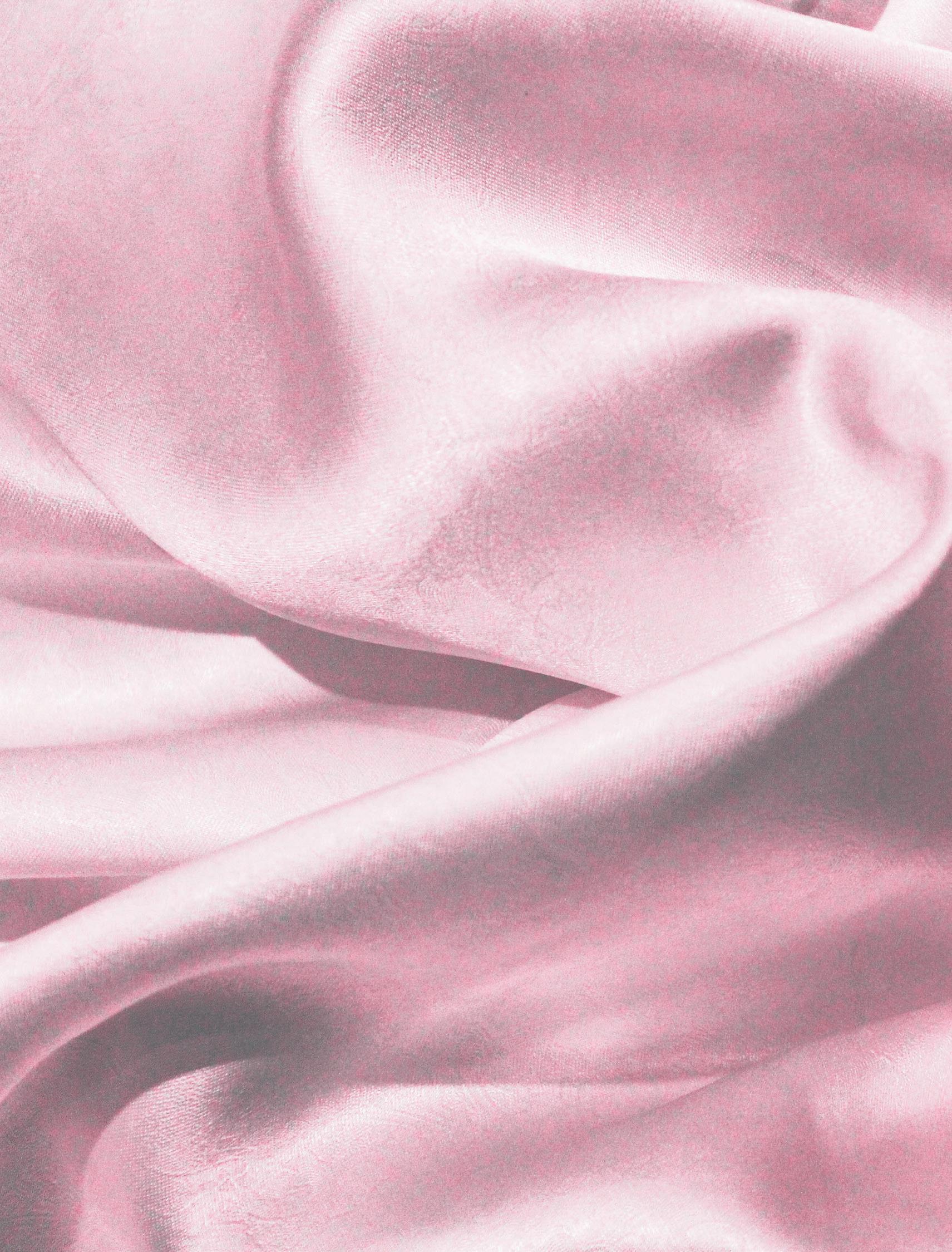


Smile On Seniors (SOS) was founded in 2016 by Rabbi Menachem and Esther Stern to fill an unmet need. Growing old should be the golden years in one’s life, but for many it is also a difficult time. Moving into a group home, which offers care, may be a necessity, but doing so means being apart from family and possibly losing some independence. For those who move into a non-Jewish aged care facility it may also result in being cut off from their Jewish heritage.
That’s where Smile On Seniors comes in. It brings the joy and excitement of Judaism to Jewish seniors in non-Jewish aged care facilities across Melbourne. SOS currently reaches more than 250 seniors in 12 facilities, partnering youth with an elderly ‘grandfriend’. The organisation sends seniors packages and personalised postcards, hosts face-to-face and Zoom meetings with young
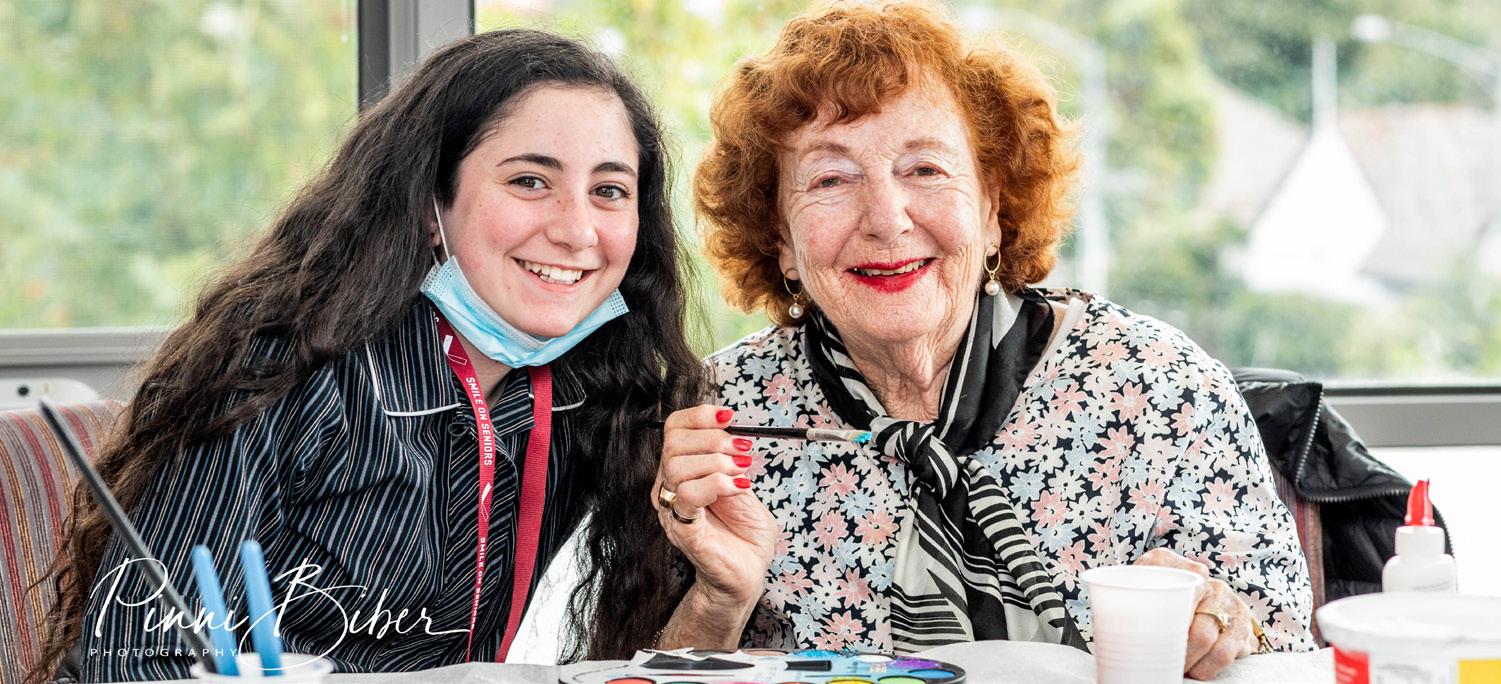
people and seniors, orchestrates concerts and organises programs for Shabbat and chagim. Sponsored by the Glen Eira City Council, Victorian government, Bendigo Bank and other private donors, during COVID-19 SOS launched its Shabbat Hug Program.
SOS has partnered with schools including Beth Rivka Ladies College, Bialik College, The King David School, Leibler Yavneh College and Mount Scopus Memorial College. It has also done so with organisations including AUJS, Chabad Glen Eira Bar Mitzvah Group, Hamerkaz Centre Bat Mitzvah Group, Hineni and WIZO Kids Victoria, among others.
Smile On Seniors is always looking to expand its volunteer base to reach as many seniors as it can. Those interested should go to: www.smileonseniors.org.au/volunteering SOS is a not-for-profit organisation and relies upon its generous supporters to continue its fine work. You can make a tax-deductible donation at www.smileonseniors.org.au/donation
9 the melbourne jewish report | November 2022
MACCABI VICTORIA
From left: Maccabi Victoria co-presidents Dean Mohr and Sharon Roseman, and immediate past president Brian Swersky
ARGYLE PINKS DIAMONDS as well as other COLOURED DIAMONDS are available at Ian Sharp Jewellery. Start your Pink journey with us today. There is nothing on earth quite like an Argyle Pink Diamond. The returns on pinks have outpaced the stock market and the Argyle mine has ceased production as of the end of 2020. With no more new supply, now is the time to get your rare Pink Diamond. – RARE –ARGYLE PINK DIAMONDS 65 Toorak Rd, South Yarra, VIC 3141 P. 03 9866 4983 E: sales@iansharp.com.au www.iansharp.com.au IanSharp_Advert_Feb21.indd 1 5/2/21 9:41 pm
Smile On Senior’s Art to Heart Program pairs young people with seniors, helping to build rapport between generations
Australian Friends of The Hebrew University Our passion for progress
BY NOMI KALTMANN COURTESY: PLUS61J.NET.AU
Nomi Kaltmann talks with Moti Kahana, whose extraordinary success in organising the rescue of people trapped in dangerous Middle Eastern countries has made him a figure of legend
When Moti Kahana describes himself as a “humble American-Israeli farmer living a quiet life in New Jersey”, you almost believe him. As he speaks to me on the phone while walking his dog Lafayette in Randolph, New Jersey, at times interrupting our conversation to yell at his dog not to chase the chickens, his claim is almost plausible.
However, as a result of the multitude of stories written about extraordinary rescues he has coordinated over the years – from countries such as Syria, Iraq, Yemen and Afghanistan – Kahana’s description of himself seems unlikely.
“Up until a few years ago, I was involved in business my whole life and I had nothing to do with politics,” he says. “I am an Israeli. I used to vote Likud and I grew up in a poor neighbourhood in Jerusalem, where everyone was a fan of Beitar Yerushalayim [an Israeli football team].”
Kahana, now 53, served in the Israeli Air Force, before moving to the United States about 30 years ago. Like so many Israelis before him, he arrived armed with spades of Israeli chutzpah and a desire to create an American dream. Kahana says he originally went for a 10day visit, but liked it so much he decided to stay. “I am an out of the box kind of a guy and on a personal level I always need a challenge or problem to work on,” he says.
In America, Kahana founded the rent2buy car rental company, which became extremely successful. “When I started my business, I thought about how I could be better than other existing car rental companies. I created systems that recycled the gasoline. I created a novel idea of having video camera inspection systems and I started to rent cars to people under 21 years of age, to create new business opportunities.” His innovative approach paid off and the global car rental giant Hertz took note and acquired his business for an undisclosed sum.
Despite fulfilling the American dream of becoming a self-made millionaire, Kahana found that he was bored. “I always need challenges and problems in order solve them to keep myself entertained,” he says. Shortly after the sale of his company, Kahana visited Israel. “When the Arab Spring began in 2011, I had money, nothing to do and I had recently visited Yad Vashem. I empathised a lot with the people [of all nationalities] in the Middle East who were getting shot and I decided to get involved and see what I could do to help,” he says.
“Around the time I visited Israel, the Libyan civil war against Gaddafi had begun. I knew people from business who connected me with Chuck Perry [the US senator from Texas].” Perry was trying to get SIM cards and satellite
Israeli-US farmer who masterminds international rescue missions
with terrorist groups nor the payment of ransoms, Sotloff was a dual Israeli/ American citizen. Kahana waited to see if he could get tacit approval from the Israeli government to begin negotiations for Sotloff’s release.
“ISIS did not know that in addition to being American, Stephen was also Jewish and an Israeli citizen. After the Israeli government allowed me to proceed with organising Stephen’s release, I negotiated a $US5 million payment to release Stephen, along with his fellow hostages, [Brit] James Foley and [American] Kayla Mueller.”
But sadly, the rescue mission and ransom payment did not take place.
“After the $5 million ransom was negotiated, it took three days to organise the funds to transfer to the people who were holding Stephen and the others. During this time, the city of Mosul in Iraq fell to ISIS. Once ISIS had taken over [the oil-rich] Mosul, they had billions of dollars in the banks, so they decided that they no longer needed the ransom payment,” he says.
In Kahana’s mind, there is no doubt why this ransom was rebuffed. “I consider the case of Stephen Sotloff one of my biggest failures,” he says. “Once Mosul fell, ISIS needed media attention more than a $5 million ransom. They already had enough money from Mosul, so they decided to chop off Stephen’s head.” Sotloff and James Foley were publicly beheaded by ISIS in 2014. Mueller was killed in an airstrike.
wanted to upload videos to the internet showing Gaddafi shooting and killing his own people. “Chuck Perry contacted me via mutual business associates and asked me to source satellite phones with internet access for Libyans. Perry connected me to a Palestinian guy working in Libya, called Mouaz, who grew up in Damascus,” says Kahana. Together, Mouaz and Kahana were successful in delivering SIM cards and satellite phones to the Libyans.
“Right after Libya, in March 2011, the Syrian revolution started and Mouaz became involved in Syria because he had family living there,” Kahana says. Having formed a strong bond with Mouaz through their successful mission in Libya, Kahana became involved in Syria.
“After the chemical attack [on his own people by Syrian dictator Bashar Al Assad], I decided that that this was the time to get more involved in the humanitarian diplomacy side,” Kahana says. At first, he was involved in smuggling passports in and out of Syria for dissidents, later moving on to missions that helped extract people from Syria and the occasional mission to bring people into Syria.
Originally, Kahana’s rescue missions were humanitarian in nature and all the people he rescued were not Jewish. But
Syrian Jewish leaders living in New Jersey, where there is a large community, began contacting him concerned about the welfare of the small number of Syrian Jews that remained in the country.
“I got a call from a rabbi in New Jersey saying that there was a Jewish Syrian man who had cancer. The rabbi asked me to help bring him to Istanbul.” Kahana obliged and took a critical role in rescuing the man and his family. “I had already been active in Syria for a few years, but after this rescue, another rabbi who had heard of my work in Syria called me to his office and said he needed help rescuing 47 Jews from Yemen.”
“I said to the rabbi, ‘I am not the Jewish Agency, I can’t do it!’ But he was very persistent.” Kahana agreed to help and after months of complicated planning, logistics and paperwork, he successfully orchestrated a rescue mission.
As his reputation and success in extracting people from inaccessible countries began to spread further, he was not overly surprised when the family of American/Israeli journalist Stephen Sotloff contacted him to ask for help. Sotloff had been captured in Syria in 2013 and was being held by ISIS, who were keen to negotiate his release for a hefty sum. While American government policy does not allow for direct negotiations

When the Taliban took control of Afghanistan in August 2021, Kahana was the obvious choice to try to help rescue the last Jew remaining in the country, Zevulun Simantov. Kahana says that rescue, though ultimately successful, “was very difficult”. “While the actual mission was very short, convincing Zevulun to leave Afghanistan took many sleepless days and nights on my end.”
According to Kahana, extracting someone is usually the least complicated part of the rescue. “Most complications are the people you rescue, not the enemy,” he says.
“The people you rescue, they don’t have papers, or they often have complicated family situations. The most difficult thing is actually the talking you do with them prior to the mission, where you are required to behave like a psychiatrist 90 per cent of the day, where you have to listen and reassure them.”
“Because of the mission to rescue Zevulun Simantov, I have been able to save thousands of people from Afghanistan,” says Kahana. “To this day, practically every day of the week my company [GDC Security] continues to rescue people from Afghanistan.”
When asked about his next mission, Kahana laughed down the phone. “I am no Elon Musk, but maybe getting to Mars will be harder! If you set your mind to it, you can get anywhere. I believe anything can be done.”
10 the melbourne jewish report | November 2022
Moti Kahana (photo by Elliot La Mer)
JEWS AROUND THE WORLD
Moral responsibility

 RABBI YAAKOV GLASMAN
RABBI YAAKOV GLASMAN
The story is told about a monkey that suddenly went missing from the zoo.
The zookeeper frantically looked for him in each cage and in every nook and cranny of the zoo, but couldn’t find him anywhere. Finally, the zookeeper decided to look in the only place he hadn’t yet checked – the zoo library. To his astonishment, he found the monkey sitting at one of the desks holding a bible in the one hand and Darwin’s “Origin of the Species” in the other.
Incredulous, the zookeeper asked the monkey: “What on earth are you doing here?” The monkey turned to the zookeeper with a confused look on his face and said: “I was trying to work out whether I am my brother’s keeper or my keeper’s brother.” Corny jokes aside, interpersonal responsibility, or assuming the role of our brother’s keeper, goes to the very heart of our Jewish faith. While some people make the common error of dismissing those commandments that exist between man and G-d, others make the same error by excluding those mitzvot between man and man.


Judaism teaches us that both these approaches are equally erroneous.

















The Torah places mutual emphasis on both sets of laws and neither may be


practiced at the exclusion of the other. The two are in fact complimentary. To be sure, one of most critical components of Judaism – the Ten Commandments –is split down the middle on this issue.








Five are interpersonal commandments and the other five are between man and G-d. Belief and worship of G-d necessitates a respect for G-d’s creations (our fellow man) and respect for G-d’s creations is predicated on an appreciation of their Creator.
A tragic scene depicted in the Torah speaks of the lonely corpse. A human being was murdered and left for dead in an open field. The killer is nowhere to be found and there seem to be no clues as to who committed this atrocious act. In this case, the law is simple yet profound. The spiritual leaders of the closest city to which the corpse was discovered must travel to the scene of the crime and atone. The priests (Kohanim) must then recite blessings and invoke the name of G-d to further this atonement.
The following questions are asked. The rabbis and Kohanim were not responsible for this man’s death, so why should they have to atone for it? And if atonement is, indeed, necessary, then why don’t they simply send a delegate or agent in their place to complete the task? Surely the rabbis could find better things to do with their time than spending the day travelling to the outskirts of the city for this most morbid of rituals?
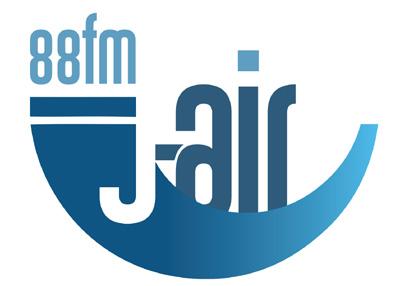
The lesson goes to the very core of what Judaism stands for. It’s not enough to be a good Jew, without regard for those around us. We cannot turn a blind eye to other people’s plight, enjoying the security of our own wellbeing. If we are aware of someone else’s misfortune, the metaphoric “corpse” in their lives, we may not turn our backs or simply delegate responsibility to someone else. If one is in a position to help, then one must do so no matter their standing in the community. They may me rabbis or Kohanim, communal leaders or wealthy entrepreneurs, politicians with influence or lay people on the backbenchers. Ultimately, the buck stops with everyone who possesses a moral compass to exit their comfort zone and travel to the outskirts of the city to assist those in need. After all, if we are not our brother’s keeper, who else will be?

11 the melbourne jewish report | November 2022
J-AIR 88FM Listen Anywhere, Anytime j-air.com.au RABBINIC THOUGHT
Pictured with Rabbi Yaakov Glasman (left) and Chazzan Brett Kaye is Benjamin Cohen, who read the Ten Commandments for his Bar Mitzvah.
RABBINIC THOUGHT
BY RABBI YUVAL CHERLOW

Once people understand that it's God's will that we protect our world, many more should be willing to embrace the environment as a worthy cause.
One of the most powerful lessons from the Torah relates to the order in which it was written, specifically in how it begins. An event that from a national or religious perspective would seem to be the penultimate event to begin the Torah would be the covenant between God and the Jewish people.

While this is certainly a topic given great prominence later on in the text, the Torah begins somewhere else altogether. The Torah begins with the creation of the world, an event of universal importance to all peoples, of all religions.
Furthermore, The Torah makes no religious distinction and writes that all humanity has been created in the image of God and we are all an outgrowth of Adam. The text continues with: “Be fruitful and multiply, and replenish the earth, and subdue it; and have dominion over the fish of the sea, and over the fowl of the air, and over every living thing that creeps upon the earth.”

This is a universal commandment, not limited to any people, based on faith or belief. In so doing, the Torah makes it
Judaica quiz answers
1. Song of Songs (Shir Hashirim) 2. Final Mem – top row
France 453,000 4. He was a German diplomat. He is remembered for his assassination in Paris in 1938 by a Polish Jewish teenager, Herschel Grynszpan, which provided a pretext for Kristallnacht. 5. Samson and Delilah 6. In case his wife died. Based on Leviticus 16:6 where it says: “And he shall make atonement for himself and for his house” – the rabbis ruled that the Kohen Gadol should be married. Rabbi Yehuda was concerned that the Kohen Gadol’s wife would die just before Yom Kippur and then he would be unable to fulfil his responsibilities. 7. The Flying Dutchman 8. Ayin, Gimmel, Zayin, Tet, Samech and Tsaddi
Ein Gedi
Cardinal
Rehovot, 1934 12. Pianist from Buenos Aires, Argentina 13. The Cairo Genizah is a collection of some 400,000 Jewish manuscript fragments and Fatimid administrative documents that were kept in the genizah or storeroom of the Ben Ezra Synagogue in Fustat or Old Cairo, Egypt. 14. People wear white garb, also the regular Ark curtain, Bimah cover and Sefer Torah mantles are replaced with white coverings. 15. Mayor of Jerusalem 16. Unetaneh Tokef 17. iii) 19
Religion in service of climate
will, many more will inevitably be willing to embrace this cause. Indeed, many of the world’s leading religions already have sustainability built into ethical codes. Judaism itself prohibits cutting down fruit trees during times of war, explained by many commentators as a general prohibition from environmental destruction.Shabbat is an additional example, for even though it presumably was not intended as an environmentally friendly institution, the very fact that we stop travel, production, industry and other polluting activities every seven days has a definite positive effect on ecology.
Moreover, religion for the most part urges believers to abstain from overly materialistic lifestyles and favours values like spirituality, kindness and compassion over the drive for the newest, the best and the most.
very clear that our original focus is on the common themes amongst all humanity and not what might divide us.
Perhaps one of the most important lessons that we can take from this is the significance of being created in the image of God with regard to our responsibility towards the world around us.
This is a responsibility that is expanding because it is abundantly clear that we –as humans – are the ones who do more damage to the environment than any other living thing.
18. The names of the bridegroom and the bride are inscribed in the ketubah –two religious men (over Bar Mitzvah and unrelated to each other or the bride and groom) act as witnesses and sign in Hebrew at the bottom of the ketubah 19. André Citroën (1878–1935), founder of Citroën 20. HMT Dunera 21. It would be enough for us 22. Either because they thought of themselves as Shomrim i.e. Guardians/ Keepers/Watchers (of the Torah) or because they lived in Samaria. 23. In Medieval French and German the name Caplin/Caplain/Chapelain was often an occupational name for clergymen. It eventually gave rise to the English word ‘chaplain’. Jews who were kohanim i.e. priests were often given this name. 24. Zikhron Ya'akov 25. Nestlé
Spelling bee answers

Jewish Answer – SHTIKEL. Here is a list of some common words (“yes”, we know there are more words in the dictionary that can work, but these words are common to today’s vernacular): HIKES, KETTLE, KETTLES, KILLS, KILTS, KISHKE, KISHKES, KISSES, KITES, KITTIES, LEEKS, LIKELIEST, LIKES, SEEKS, SHEKEL, SHEKELS, SHEIKH, SHEIKHS, SILKIEST, SKIES, SKILL, SKILLET, SKILLETS, SKILLS, SKITS, SKITTISH, SLEEK, SLEEKEST.

Questions/comments – email Yoni at koshercroswords@gmail.com
It is also we (alongside all other living things) who will bear the brunt of that reality if our world is destroyed. I would therefore argue that religion and religious leaders must act at the centre of the effort to preserve our environment and advocate for measures that will create a more sustainable world. Religion is uniquely positioned to take on the ambitious task.
While environmental protection is, of course, motivated by universal human interests, once people understand that protecting our world is also God’s
Of course, religion is not always used as a champion for good and we know that many millions of people have been killed by those acting in the name of religion. It is therefore imperative that our religious leaders act responsibly to advance causes that will protect our environment, which we hope can also create a more harmonious and peaceful world.
12 the melbourne jewish report | November 2022
3.
9.
10.
11.
Rabbi Yuval Cherlow is the director of the Tzohar Center for Jewish Ethics and a founder of the Tzohar Rabbinical Organization in Israel.
Rabbi Yuval Cherlow (fourth from left) together with interfaith religious leaders at a recent conference
RABBINIC THOUGHT
BY RABBI DR BENJI LEVY

The wicked Turnus Rufus once challenged Rabbi Akiva by asking the following: “whose actions are more beautiful, those of God or those of man?” The rabbi replied, “those of man are more beautiful …” Rabbi Akiva showed Rufus wheat and cake and said, “this (wheat) is the work of God and this (cake) is the work of man.” (Midrash Tanchuma, Parshat Tazria)
God, by definition, represents perfection and therefore traditional Greek wisdom would hold God’s end
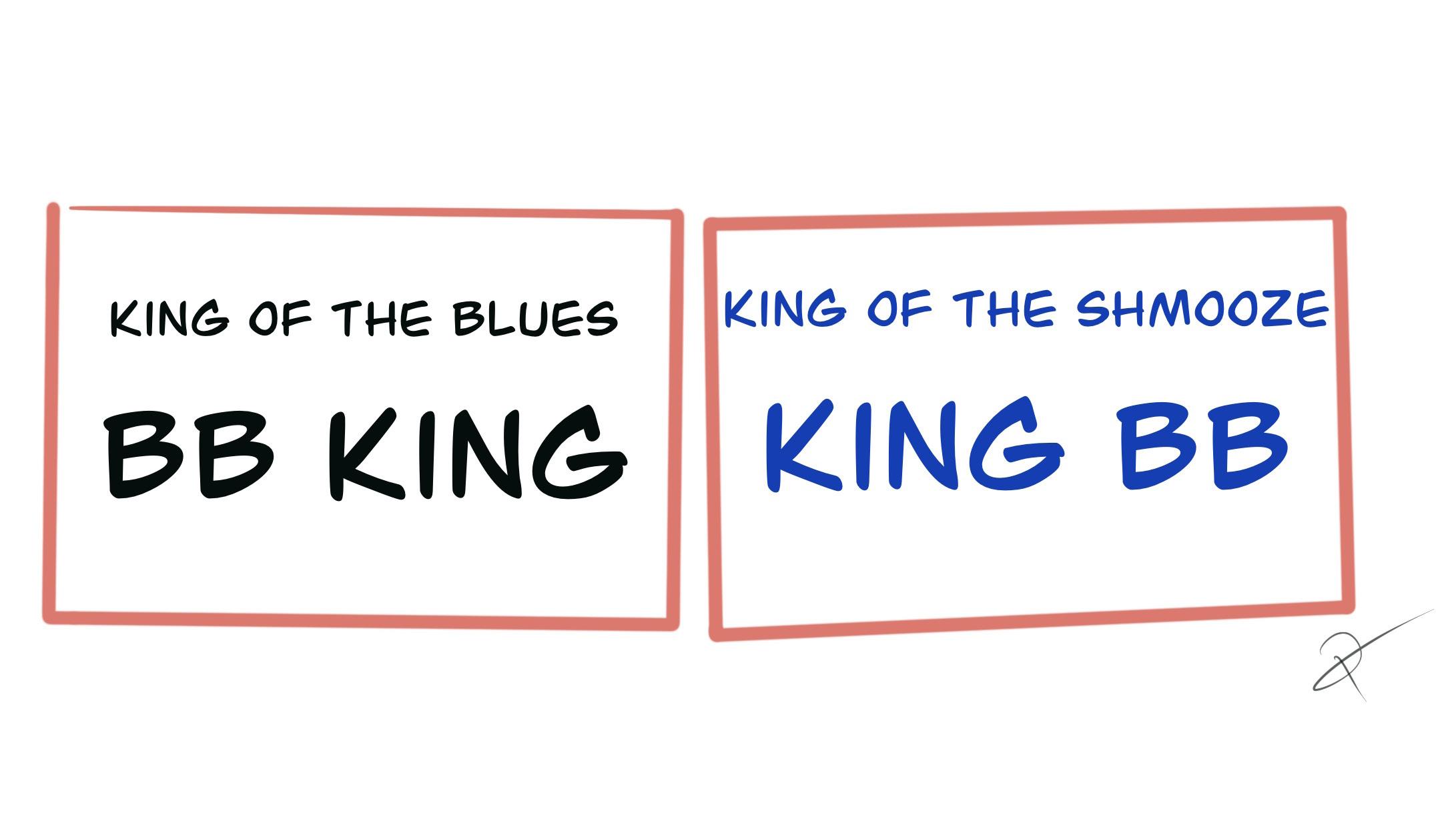
Making the most of what we have
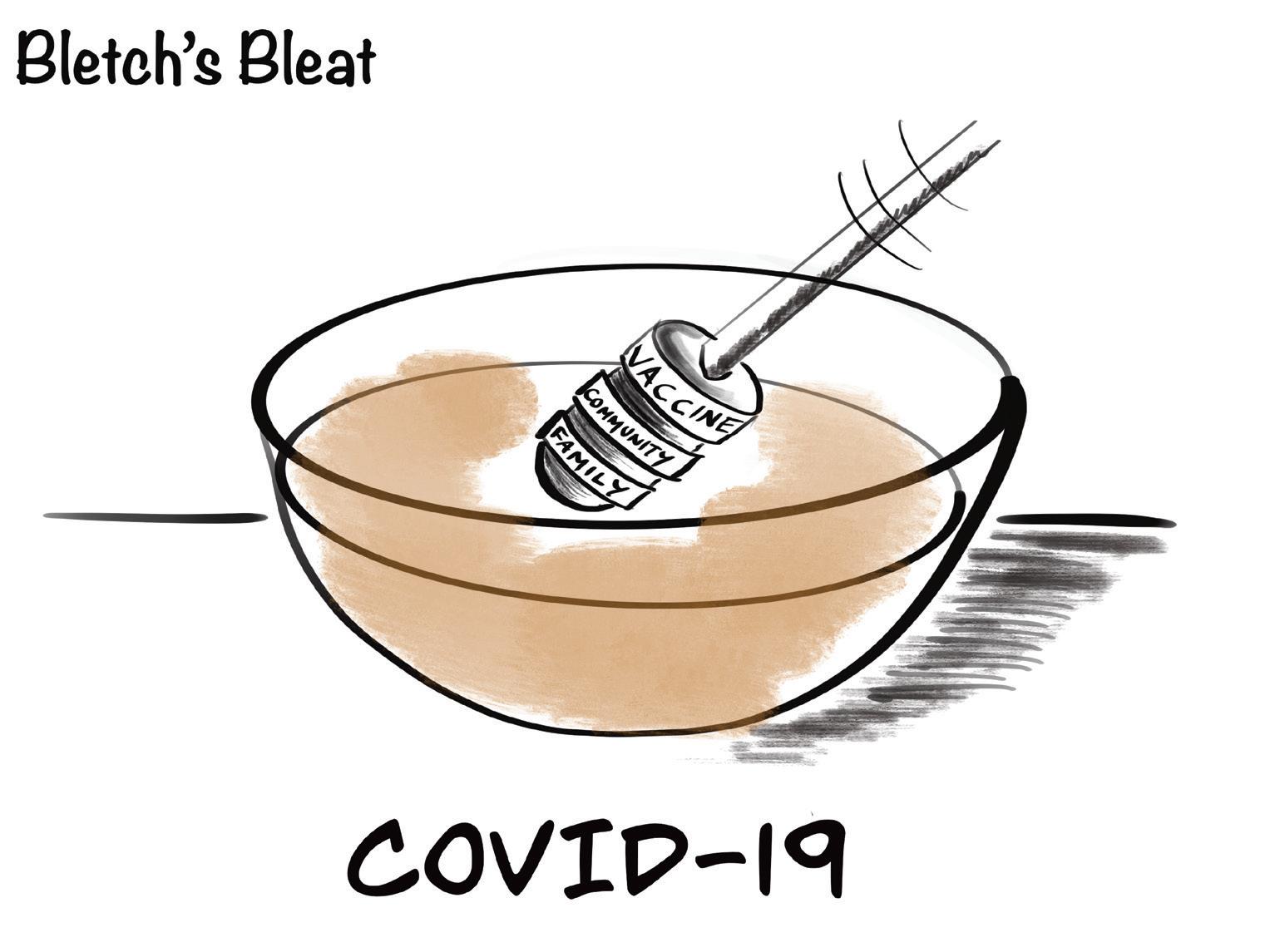

result as superior to that of man. But Judaism believes that man is summoned to finish what God starts. Sometimes we are handed lemons with which we need to make lemonade and at other times we are provided with the raw ingredients with which to “cook up a storm”.
This underlying life philosophy is exemplified through cooking, when we literally take raw ingredients and have the ability to transform them into scrumptious delicacies. Our own bodies represent the same idea – a gift from God that we must look after through healthy nourishment and exercise (both physical and spiritual).
Melbourne Jewish Report Disclaimer:
Except where expressly stated otherwise, content in The Sydney Jewish Report is provided as general informations only. The articles in this paper have been contributed by a third party. The opinions, facts and any media content here are presented solely by the author, and The Jewish Report assumes no responsibility for them. It is not intended as advice and must not be relied upon as such. You should make your own inquiries and take independent advice tailored to your specific circumstances prior to making any decisions. We do not make any representation or warranty that any material in the papers will be reliable, accurate or complete, nor do we accept any responsibility arising in any way from errors or omissions. We will not be liable for loss resulting from any action or decision by you in reliance on the material in the papers. By reading the papers, you acknowledge that we are not responsible for, and accept no liability in relation to, any reader’s use of, access to or conduct in connection with the papers in any circumstance. Photographs submitted by individuals or organisations are assumed to be their property and are therefore not otherwise credited. All articles in this paper have received the expressed consent of the author to publish in this paper.
The Jewish Report; ISSN 2204-4639
Publisher: The Jewish Report Pty Ltd (ACN 167302981)
Distributor: TJR Distribution Pty Ltd ACN 165158029
Comments or suggestions to: editor@thejewishreport.com.au
Article submissions to: www.thejewishreport.com.au/article-submission-guidelines
Advertising: editor@thejewishreport.com.au Website: www.thejewishreport.com.au
Printer: Spotpress Pty Ltd
13 the melbourne jewish report | November 2022
If you are a young Jewish person and not sure what to do to bring in the new year, this may be the answer for you. The father of a teenager is welcoming all well-behaved Jewish youngsters between the ages of 15 and 18 to a party he is throwing at Karafka Hall, 39 Dickens Street, Elwood. There will be music, kosher food and even table tennis for those so inclined. Up to 150 will be catered for. For bookings, go to trybooking.com/cdieb Party like it’s 2023 NEW YEAR’S EVE CELEBRATION CANDLE LIGHTING TIMES Friday, Nov 18, 2022 7:55 pm Shabbat ends, Nov 19, 2022 8:58 pm Friday, Nov 25, 2022 8:02 pm Shabbat ends, Nov 26, 2022 9:07 pm Friday, Dec 2, 2022 8:09 pm Shabbat ends, Dec 3, 2022 9:15 pm Friday, Dec 9, 2022 8:16 pm Shabbat ends, Dec 10, 2022 9:21 pm Friday, Dec 16, 2022 8:21 pm Shabbat ends, Dec 17, 2022 9:27 pm Friday, Dec 23, 2022 8:25 pm Shabbat ends, Dec 24, 2022 9:30 pm Shabbat ends, Jan 14, 2023 9:30 pm
Rabbi Dr Benji Levy
FOODIES'
How babka went from the shtetls of Europe to pop culture pastry
When dessert is named after grandma, you know it’s good.
Babka, lovingly named for the Eastern European Bubbes who shaped and filled the pastry for generations, has long been enjoyed by Jewish children and grandchildren the world over.
So, when did babka leave Bubbe’s kitchen and make its way to foodie main street?
Babka vendors run the gamut from Jews to non-Jews, religious to secular, mass produced to small batch specialty stores. The swirls of this flavour-filled pastry are able to unite babka connoisseurs and newbies alike – a trend that’s both heart-warming and delicious.
Perhaps the mass blogosphere frenzy surrounding Trader Joe’s tremendously beloved chocolate babka played a part. A simple Google search for “Trader Joe’s babka” sends you to an overwhelming display of the baked good obsession. Take Bridget from Bake At 350 – a Midwestern babka newbie who only knew of the pastry from an old Seinfeld episode. After taking home Trader Joe’s offering, Bridget became a babka fiend and she wasn’t alone. Trader Joe’s brought this kosher bakery special into the homes of the masses and raving five star reviews ensued.
Since 2014, kosher chocolate babka has been sold in every Trader Joe’s across the United States. In response to my questioning of the popular grocer on their colossal babka success, Trader Joe’s responded, “We believe that customers ‘vote’ on what they love and want to see in our stores with their dollars.” Hear, hear! As long as babkas keep dropping into Trader Joe’s carts, they’ll keep selling the delicious treat.
But can mass produced babka really live up to Bubbe’s confections? Enter the rise of specialty babkas and online tutorials.
Chef Shimi Aaron, an Israeli-born, LA-based chef, has made it his mission to produce artisanal babkas for a sophisticated palette. Chef Shimi’s Sephardi background (a mix of Egyptian, Iraqi and Yemenite Jewry) doesn’t lend itself to babka baking memories. While his home was always full of food and middle eastern flavours, it wasn’t until he spent extended time in London as an adult that he was exposed to babka as a popular dessert. He saw his cousin’s nanny baking the treat and was instantly hooked.
“I was really fascinated by the aesthetics of it – the taste of course too, but the technique and aesthetics is what drew me in and fascinated me. I got the recipe from her – it wasn’t great to be honest. I took it from there.” Soon after babka entered his life, Chef Shimi moved to LA and started posting his babka experiments to Instagram. Before long, his gorgeous works of art were being noticed. He ran Zoom workshops for up to 80 people at a time – inspiring his audience with the exceptional flavour and exquisite designs of his babkas. He’s been hired to create his unique babkas directly in customers’ homes to account for their special dietary needs – including vegan and kosher.
Chef Shimi has received praise for topping many of his babkas with unexpected elements like orange peels and rose petals, flavours he adapted from his humble beginnings as the child of frugal Middle Eastern immigrants. “For me these choices came naturally,” Chef Shimi explained. “I don’t like candies and artificial flavours, but as a child I used to collect orange peels from my neighbours to make orange candies with my mum. The rose petals, besides being beautiful and adding colour, remind me of my grandmother, who used rose water as perfume because they were poor.”
“I’m very proud to be able to have a piece of the success of babka in the world,” shared Chef Shimi. “It makes me very proud as an Israeli and as a Jew.”
As to what has brought babka to the wider culinary arena in recent years, Chef Shimi explained, “People love pastries and everything has its time – sourdough bread and croissants, for example. It was the right moment for babka. Everyone wanted to know how to make babka. The world is fascinated by Jewish and Israeli food!”
That fascination garnered over 7.5 million views and over 4,000 comments on Binging with Babish’s Seinfieldinspired video highlighting babka.
The comment section was alive with babka-newbies rejoicing in their fresh baked discovery.
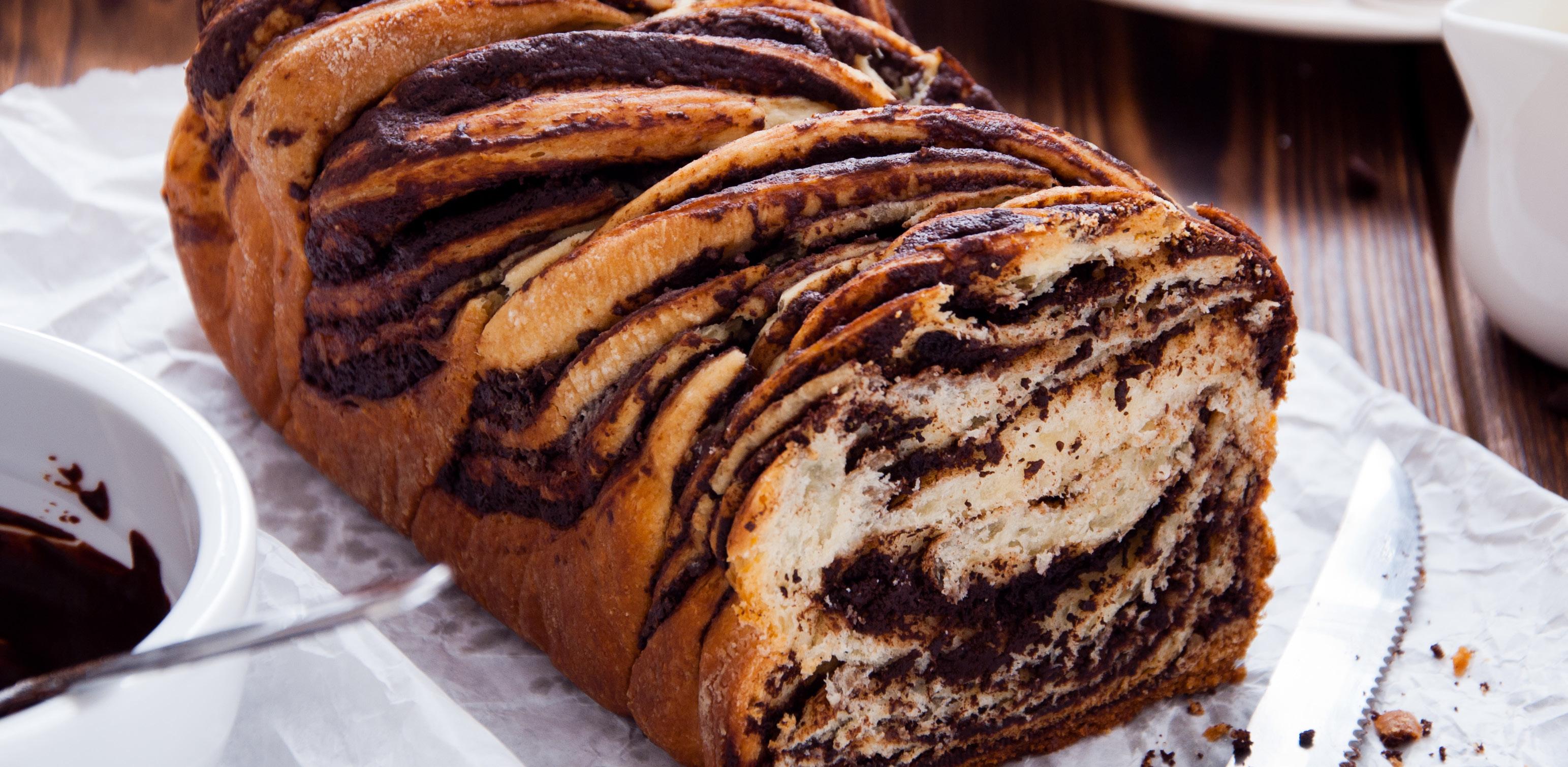
Clearly, the second part of your life can begin when babka enters the scene.
A follow-up to Binging with Babish’s babka video reached over one million views and nearly 1,000 appreciative comments.
Don’t worry, Sue, the babka addiction hit you and about a million other Trader Joe’s customers.
Tye Sule, a pastry chef who went to online culinary school, shared his first babka exploits to his large social following.
While he wasn’t assigned babka as his weekly bake, he couldn’t help but get his hands into the dough. Good call, Tye.



His comment section too was ablaze with babka fans, new and old, declaring their mouth-watering approval.
So, while we don’t know exactly who to thank for the rise of babka, it’s safe to say appreciation is in order to: a motley line up of classic sitcom writers, quirky national grocers and creative social media influencers. But, most importantly, we’d like to extend our deepest gratitude to the baba’s behind the babkas, who likely chatted in Yiddish as they expressed the nearly universal Jewish Bubbe love language: feeding the best to their family and friends.
Bake ‘em or buy ‘em – just remember to ask each new babka taste tester to try to settle the decades old debate: cinnamon or chocolate?
14 the melbourne jewish report | November 2022
BY LAURA LABOVITZ COURTESY AISH.COM CORNER
THEATRE REVIEW
Cameron Mackintosh’s new production of Andrew Lloyd Webber’s masterful work The Phantom of the Opera sizzles. Everything about the production works a treat.

Andrew Lloyd Webber’s music, a cavalcade of riches, still stirs the soul 36 years after the musical debuted in London.
In this case, plaudits to Orchestra Victoria for bringing it to life, with Anthony Barnhill conducting.
After a prologue involving a Paris Opera House auction, set in 1919, the story turns to events at the grand opera in 1881.
As the cast is preparing for a new production of Hannibal, the opera house manager announces his retirement.
For three years “accidents” have been happening regularly at the theatre and now there is another near miss, which is blamed on “the opera ghost”.
The resident soprano Carlotta Giudicelli storms out.
Rather than cancel a sold-out performance, a young chorus girl with a well-trained golden voice, Christine Daae, steps in.
The opera’s new patron Raoul, Vicomte de Chagny recognises Christine from their childhood and begins to woo her. It turns out that Christine’s singing has been inspired by a gifted composer
MOVIE REVIEW
Magnificent musical
and grossly disfigured man who she has never seen.
It is his (The Phantom of the Opera’s) jealousy that informs the rest of the narrative as he casts a large shadow over all future productions at the opera house.
The phenomenal talent on display at the State Theatre brings out the very best in Phantom. Australian-American soprano Amy Manford, who stars as Christine Daae, has the most angelic of voices.
She is nothing short of breathtaking, having previously assumed the role in London’s West End and in Athens,
Greece. The timber in Josh Piterman’s pipes and the angst he displays in the title role, which he also played to critical acclaim in the West End, are captivating.
Blake Bowden, too, impresses as Raoul, Vicomte de Chagny.
The confrontational scene where he, Manford and Piterman cross paths and “sing their lungs out” is one of the musical’s many highlights.
Australian-Italian Soprano Giuseppina Grech, who performs regularly with Opera Australia, fittingly shines as the opera star Carlotta Giudicelli.
Another with considerable West End
The power game
One of the great Nordic mysteries, Margrete: Queen of the North is inspired by the remarkable true story of a fearless female ruler.
It is 1402 when a 50-year-old achieves what no man has managed before.
After centuries of bloody war, Margrete (Trine Dryholm) brings together Norway, Denmark and Sweden in a peaceful union.
As a woman, she is forbidden from ascending to the throne, so she governs indirectly through her adopted son, King Erik (Morte Hee Andersen).
Despite her achievement, the alliance is precarious, with the fledgling Nordic union beset by enemies.
So, she hatches a plan to secure the territory’s future and help prevent it being overrun by the Germans.
She brokers a marriage between Erik and English princess Philippa (daughter of King Henry V).
What she is not anticipating is a conspiracy within her own ranks.
One day a mysterious man (Jakob Oftebro) presents himself at the palace.
He professes to be Margrete’s dead and only biological son, thus laying claim to the throne.
Margarete is faced with an impossible dilemma, one that threatens everything that she worked for.
To say that Erik is less than pleased about the possibility of losing power is an understatement.
Subterfuge, intrigue and betrayal are in play.
Margrete: Queen of the North is the largest and most expensive production mounted in Danish film history and it shows.

It has much to commend it. I was totally absorbed. It is a superbly constructed work, with twists aplenty. Much credit
to writers Jasper Fink, Maya Ilsoe and Charlotte Sieling (the latter of whom also directs).
Trine Dryholm is magnificent in the lead role. Her confidence and authority shine through in a dominant display.
But she is far from alone in impressing.
Around Margrete, with much at stake, the schemers are plentiful.
A handful of actors bring credibility and clout to their respective characterisations.
experience in a role he has made his own is tenor Paul Tabone.
He plays up to perfection the indignant opera leading man Ubaldo Piangi, Giudicelli’s lover.
Jayde Westaby is a force to be reckoned with as the no nonsense Madame Giry, while Mietta White adds spark as her daughter Meg.
The set design by Paul Brown is a visual feast – a contrast of light and darkness between the gilt-edged opera house and the Phantom’s lair.
The appearance of steps as the Phantom leads Christine to his quarters via gondola and fog is a stroke of genius.
Pyrotechnics also play a significant part in proceedings, as do special effects wizardry.
So it is that The Phantom of the Opera is fiery, both figuratively and literally.
Choreographer Scott Ambler certainly had his hands full with scenes involving the full cast and has done a wonderful job.
The costuming is opulent and plentiful, a tableau of creativity by Maria Bjornson.
And this Phantom wouldn’t be as great as it is without the efforts of lighting designer Paule Constable and sound designer Mick Potter.
Directed by Laurence Connor, this mesmerising production is a theatrical triumph of the highest order.
The Phantom of the Opera is playing at the State Theatre, Arts Centre Melbourne, until 5th February, 2023.
The wild country serves as another character in the film, thanks to the quality cinematography by Rasmus Videbaek.
The tension Is ratcheted up by composer Jon Ekstrand’s compelling score.
Rated MA, Margrete: Queen of the North is well worth seeing and scores a 7½ out of 10.
15 the melbourne jewish report | November 2022
MARGRETE: QUEEN OF THE NORTH (MA) BY ALEX FIRST
THE PHANTOM OF THE OPERA BY ALEX FIRST
Photo by Daniel Boud








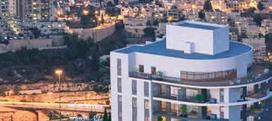
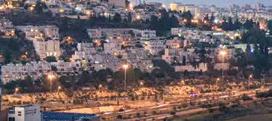
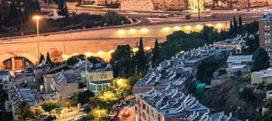











































 RABBI YAAKOV GLASMAN
RABBI YAAKOV GLASMAN



















































